
About UsThe Numismatic Bibliomania Society is a non-profit organization devoted to the study and enjoyment of numismatic literature. For more information please see our web site at coinbooks.org SubscriptionsThose wishing to become new E-Sylum subscribers (or wishing to Unsubscribe) can go to the following web page link MembershipThere is a membership application available on the web site Membership Application To join, print the application and return it with your check to the address printed on the application. Membership is only $20 to addresses in the U.S., $25 for First Class mail, and $30 elsewhere. For those without web access, write to: David M. Sundman, Treasurer
AsylumFor Asylum mailing address changes and other membership questions, contact David at this email address: dsundman@LittletonCoin.com SubmissionsTo submit items for publication in The E-Sylum, just Reply to this message, or write to the Editor at this address: whomren@gmail.com BUY THE BOOK BEFORE THE COIN |
- WAYNE'S WORDS: THE E-SYLUM SEPTEMBER 6, 2015
- NBS REGIONAL EVENT ORGANIZERS SOUGHT
- CHARLES DAVIS SALE CLOSES SATURDAY, SEPTEMBER 12, 2015
- NEW BOOK: ROBERT SCOT NOW PUBLISHED
- NEW BOOK: A HISTORY OF THE SOVEREIGN
- NEW BOOK: LONDON MINT OF CONSTANTIUS AND CONSTANTINE
- BOOK REVIEW: 100 GREATEST WOMEN ON COINS
- BOOK REVIEW: GEO SCIENCES IN MEDALS AND COINS
- HAROLD B. MATTINGLY (1923-2015)
- EVELYN NEWMAN (1920-2015)
- GOBRECHT JOURNALS #1-120 NOW ONLINE
- NOTES FROM E-SYLUM READERS: SEPTEMBER 6, 2015
- MEDAL COLLECTORS OF AMERICA SPECIAL OFFER
- MORE ON THE SAINT-GAUDENS CORNISH MASQUE PLAQUETTE
- CHARLES N. BODEY (1834-1904)
- MORE ON WILLIAM WEEKS
- NUMISMATIC WORD USAGE OVER TIME
- LECTURE: RESTORING THE JACOB PERKINS BUILDING
- CHARLES BARBER CORRESPONDENCE ARCHIVE
- HENRY VOIGT’S SURETY BOND
- MACOMB BATTLE OF PLATTSBURGH GOLD MEDAL OFFERED
- NUMISTORICA.COM
- MAJOR AWARDS FOR KAMPMANN AND PELLETIER
- VIDEO: TECHNOLOGY AND NUMISMATIC JOURNALISM
- THE E-SYLUM, GOOGLE, AND NUMISMATICS ON THE INTERNET
- VIDEO: DAVID FANNING ON THE MARGO RUSSELL LIBRARY
- DANA BICKFORD'S PATTERN COINAGE
- MORE ON THE SOUTH CAROLINA OBSOLETE BANKNOTE HOARD
- NEW £20 COIN HOLDS FIVE PORTRAITS OF ELIZABETH II
- ARCHIVES INTERNATIONAL SALE XXVIII HIGHLIGHTS
- A GOLD SIGISMUND III PORTUGALÖSER OF POLAND
- GORNY & MOSCH AUCTIONS 232-234
- ARTIST WESLEY KLASSEN SUBMITS DESIGNS FOR CANADIAN COINS
- ARTIST TURNS ENGLISH BANKNOTES INTO SCOTTISH MONEY
- NEW ZEALAND BANKNOTE TO FEATURE SIR EDMUND HILLARY
- BRITAIN'S £20 POLYMER BANKNOTE ANNOUNCED
- CANADIANS CUT $20S IN HALF AND SPEND THEM
- COLONEL BERNARD BERNSTEIN, RESTORER OF NAZI PLUNDER
- CELEBRATE EMPEROR NORTON EMPIRE DAY SEPTEMBER 17TH
- STEVE WOZNIAK'S PERFORATED PADS OF $2 BILLS
Click here to access the complete archive
To comment or submit articles, reply to whomren@gmail.com
WAYNE'S WORDS: THE E-SYLUM SEPTEMBER 6, 2015

New subscribers this week include: Orva Detrick, courtesy of Jeff Starck, Brian Adkinson, Fritz Voecks, George Coker, and David Finkelstein. Welcome aboard! We now have 1,876 subscribers.
This week we open with a note on NBS regional meetings, a reminder about Charlie Davis' upcoming sale, three new books, two reviews and unfortunately, two obituaries.
Other topics include The Medal Collectors of America, numismatic word usage, Jacob Perkins, Charles Barber, technology and numismatic journalism, the Margo Russell library, Bickford's pattern coinage, and Emperor Norton Empire day.
To learn more about the Sovereign, the geo sciences in medals and coins, Harold B. Mattingly, Charles N. Bodey, cleaning verdigris from copper coins, Henry Voigt's surety bond, the Battle of Plattsburgh medal, the South Carolina banknote hoard, gold $1 coin vignettes on obsolete banknotes, radioactive waste, Laser Safety Officers and Steve Wozniak's perforated pads of $2 bills, read on. Have a great week, everyone!
Wayne Homren
Editor, The E-Sylum
NBS REGIONAL EVENT ORGANIZERS SOUGHT
Pat McBride of the Pennsylvania Association of Numismatists writes:
PAN would love to offer NBS members our May and Oct shows as a destination point. We would offer space for a meeting or gathering. The Burns Library will be consistently set up at the PAN shows and could act as a base of operations. We would be more than grateful for maintenance help, list creation, bookplate insertions, book donation solicitations and input from bibliophilic experts. Keep in mind it is not PAN's library. It is publicly maintained from contributions and is everyone's library.
October 24, 2015: Fall PAN Show: Organizer needed
November 6, 2015: Whitman Baltimore Show: Len Augsburger and Wayne Homren
February 5, 2016, Long Beach: Organizer needed
May 7, 2016, PAN Spring Show: Organizer needed
To read the earlier E-Sylum article, see:
NBS REGIONAL EVENT ORGANIZERS SOUGHT
(www.coinbooks.org/esylum_v18n35a02.html)
CHARLES DAVIS SALE CLOSES SATURDAY, SEPTEMBER 12, 2015
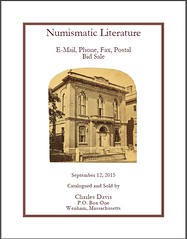 The Charles Davis sale of numismatic literature with consignments of early American auction sale catalogues, major works on U.S. Large
Cents, and some 300 significant lots of major works on Greek, Roman and Byzantine coins will close Saturday September 12.
The Charles Davis sale of numismatic literature with consignments of early American auction sale catalogues, major works on U.S. Large
Cents, and some 300 significant lots of major works on Greek, Roman and Byzantine coins will close Saturday September 12.
Highlights include
- Crosby’s Early Coins of America, unbound in its original 11 wrappers
- The Charles Horning collection of 130 Bangs catalogues
- 20 early plated American catalogues including many of the tough Chapmans - Henderson, Taylor-Windle, Bascomb & Brown, Alvord, Jenks, Sleicher, and two Stickneys.
- A 75 lot section of large cents including Howard Newcomb’s annotated copy of his work of the Cents of 1816-1857
- 300 lots of Greek, Roman and Byzantine including numerous early 20th century plated catalogues from Hirsch, Naville, Sothebys etc as well as standard references (Jenkins Gela, Grose McClean, original MFA Boston, and Schlumberger’s rare 1884 foundation work on Byzantine seals.
- The British section includes a priced and named Montagu, a finely bound sales room copy of the 1954 Farouk catalogue, and a set of Forrer’s Biographical Dictionary.
- Long runs include an attractive bound run of the Numismatist 1894-1946, an equally long bound run of the Numismatic Chronicle 1860-1920, and a complete set to date of the Sylloge of Coins of the British Empire.
The catalogue is posted on www.numisbook.com. Of the 993 lots, photographs of 350 are posted at http://www.charlesdavisnumismatics.com. Any not posted will be so on request.
THE BOOK BAZARRE
NEW BOOK: ROBERT SCOT NOW PUBLISHED
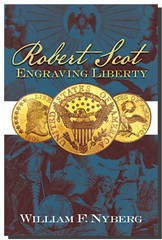 American History Press in Staunton, Virginia is pleased to announce the publication and availability of our newest book: “Robert Scot –
Engraving Liberty” by William F. Nyberg.
American History Press in Staunton, Virginia is pleased to announce the publication and availability of our newest book: “Robert Scot –
Engraving Liberty” by William F. Nyberg.
As many of you know, Robert Scot was an important figure in early American colonial history, and a friend of such luminaries as Thomas Jefferson and George Washington. He was a prolific engraver, and much of his work can be found on early American coinage, maps [including the famous Siege of Yorktown map], paper currency, and various medals and books. In addition, the first encyclopedia published in America was enhanced by his superb work.
Until now despite his significant achievements, this friend of the Founding Fathers has largely remained unknown to both historians and the general American public. William Nyberg’s extensive research of Scot and the world he lived in now allows his story to be told for the first time. This enthralling biography justifiably places Robert Scot among the most important and influential of early American artists. Endorsements
“A superb work and important contribution to the study of early American numismatics. Nyberg's engaging narrative, built upon hundreds of primary sources, is equally authoritative and readable. A complete examination of Scot's engraving work, including coins, medals, paper money, seals and revenue stamps, is long overdue, and Nyberg is fully up to the task.” - Leonard Augsburger, co-author of The Secret History of the First U.S. Mint
"In this well-written and carefully researched book, William Nyberg has given life to a shadowy figure from the early years of the Philadelphia Mint. Not only was Chief Engraver Robert Scot a superb line engraver, but his efforts on our coinage have now emerged to give him a long overdue recognition. Those collectors interested in our early coinage will do well to obtain this fine reference for their library." - - Robert Julian, author of Medals of the United States Mint
"The wealth of new information found within this volume sheds new light, greatly enhancing the respect and admiration for the work of Robert Scot." - - Steve Tompkins, author of Early United States Quarters 1796-1838
Specifications
Format: 6" x 9" paperback on permanent paper, printed in the United States
Pages 252, including Preface and Acknowledgments, Text, Chapter Notes, Appendix: Robert Scot Register of Engravings, Bibliography, Index, About the Author
Illustrations: 76 [printed on coated paper, and arranged in an Image Gallery] which include maps, copper plates, coins, paper currency, period photographs, period engravings, newspaper advertisements and paintings
ISBN 10: 1-939995-09-4
ISBN 13: 978-1-939995-09-4
Library of Congress Catalog Number: 2015931682
Price: $24.95 (Bulk order rates are available upon request)
“Robert Scot – Engraving Liberty” is available from www.Americanhistorypress.com, Amazon.com, or your favorite local bookstore.
As an added incentive to our fellow Virginians, if you purchase the book on our website and use the discount code “vacoin” you will receive a 10% discount.
We would like to spread the news about this book to everyone who might have an interest, so questions, comments or suggestions are most welcome.
For more information, or to order, see:
Robert Scot Engraving Liberty
(http://americanhistorypress.com/index.php?main_page=product_info&cPath=1&products_id=37)
To read the earlier E-Sylum article, see: NEW BOOK: ROBERT SCOT - ENGRAVING LIBERTY (www.coinbooks.org/esylum_v18n33a04.html)
NEW BOOK: A HISTORY OF THE SOVEREIGN
 A History of the Sovereign: Chief Coin of the World
A History of the Sovereign: Chief Coin of the World
In his new book 'A History of the Sovereign: Chief Coin of the World ' , Dr Kevin Clancy, Director of The Royal Mint Museum and leading expert on British coinage, recalls the history, manufacture and design of The Royal Mint’s flagship coin. Dr Clancy brings the story of The Sovereign to life in his authoritative book, and offers a fresh perspective on the rich 500-year history of this remarkable gold coin.
Accompanied by a wealth of images, this book offers a fascinating account of the history of The Sovereign and its role in trade, politics and the spread of Britain’s influence throughout the world. Offering an insight into how The Sovereign was used, the book explores the role of money in people’s lives and its place in British culture. 'A History of the Sovereign: Chief Coin of the World' is available now for just £25.
- A full-colour, illustrated book exploring the 500-year story of The Royal Mint’s flagship coin
- A rich and compelling history of The Sovereign
- Written by Dr Kevin Clancy, Director of The Royal Mint Museum
For more information, or to order, see:
The Chief Coin of the World A
History of the Sovereign Book 2015 (www.royalmint.com/shop/The_Chief_Coin_of
_the_World_A_History_of_the_Sovereign_Book_2015)
NEW BOOK: LONDON MINT OF CONSTANTIUS AND CONSTANTINE
Coauthor Lee Toone writes:
I am pleased to be able to let you all know that ‘The London Mint of Constantius and Constantine’ has finally been published. As ever, with these things, it always takes longer than expected to deliver a finished product but it is now available from Spink priced at £50. A short piece about the book was published in the recent Spink ‘Insider’ magazine.
by Hubert J Cloke and Lee Toone
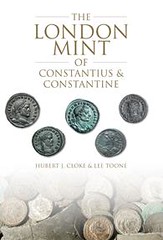 ‘A comprehensive catalogue and survey of the output of the London mint from AD 296 to 325. From when Constantius invaded Britain to regain
the Britannic Empire back from Allectus to its closure in 325 when Constantine began to shift his power base to the East, the London mint was
responsible for a vast output of Roman coinage. The Roman Imperial Coinage (RIC, volumes VI and VII)) records around 600 types; the authors of
this book have increased the number of known types to 1,037 and have illustrated 90% of these with images on plates facing the catalogue tables in
sylloge style. They have also provided a hoard census which lists numbers for each type found in four major hoards. This enables an objective rarity
value to be assigned to each coin type.’
‘A comprehensive catalogue and survey of the output of the London mint from AD 296 to 325. From when Constantius invaded Britain to regain
the Britannic Empire back from Allectus to its closure in 325 when Constantine began to shift his power base to the East, the London mint was
responsible for a vast output of Roman coinage. The Roman Imperial Coinage (RIC, volumes VI and VII)) records around 600 types; the authors of
this book have increased the number of known types to 1,037 and have illustrated 90% of these with images on plates facing the catalogue tables in
sylloge style. They have also provided a hoard census which lists numbers for each type found in four major hoards. This enables an objective rarity
value to be assigned to each coin type.’
Spink will have the book available at the Birmingham Coin Fair on 13th September and Coinex in London on 25th and 26th September. Hugh and I will be present at both shows and will be happy to answer any questions about the book and/or sign copies if required.
Spink will also have a stand at the International Numismatic Congress in Taormina, Sicily where copies should be available for inspection and purchase. I will also be there for a few days and again will be happy to answer any questions or discuss the book in general.
Finally, just a reminder that some important London mint coins from my collection are being sold in the Spink September and December auctions. The September catalogue should be online on the Spink website any day now.
For further information about the book: www.hookmoor.com/home/?page_id=44
To order the book: www.spinkbooks.com/product.php?xProd=537&xSec=47
For further information about the auction: www.spink.com/find-auctions.aspx
To read the earlier E-Sylum article, see:
NEW BOOK: THE LONDON MINT OF CONSTANTIUS & CONSTANTINE
(www.coinbooks.org/esylum_v18n23a05.html)
BOOK REVIEW: 100 GREATEST WOMEN ON COINS
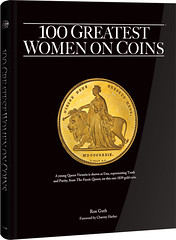 In September Whitman Publishing will release a delightful and extraordinary new book in its “100 greatest” series by award-winning
numismatic writer Ron Guth called 100 Greatest Women on Coins.
In September Whitman Publishing will release a delightful and extraordinary new book in its “100 greatest” series by award-winning
numismatic writer Ron Guth called 100 Greatest Women on Coins.
Mr. Guth was inspired to write the book after becoming interested in suffragist Alice Paul and taking an online course in 2013 on the history of American women. Those experiences made him curious about women that have appeared on coins, and more specifically, how many women have appeared on coins since a list of them could help collectors put together women-focused collections.
After compiling his own list of over 600 women that have appeared on coins throughout history, he contacted Charmy Harker, a dealer who is president of Women in Numismatics (WIN), and asked the members of that organization to select 100 women from his larger list and rank them by importance or interest.
That effort produced the list that formed the basis for his book. The women covered in it fall into four categories: “real (or actual) women; goddesses; allegorical women, who represent an idea, concept, or nationality; and women in art.”
Each of the 100 women he discusses is represented with beautiful color images of at least one coin that depicts them, a photograph of the individual, and a brief discussion of the woman and what made her unique or outstanding. He also includes a short description of how difficult it is to acquire coins that bear her image.
The first ten women, who include figures such as Mary, the mother of Jesus, Hellen Keller, Mother Theresa, Susan B. Anthony, and Cleopatra, each receive a longer essay than the other 90 women.
He notes that the women covered in the book, including the top ten, reflect the personal preferences of the 18 members of WIN who responded to his request and that they tended to prefer real women, American women, and religious women. Future editions, as he explains, are likely to cover different women as the voting base expands and changes, and that would be a welcome improvement in my view.
This is a terrific book for several reasons.
First, his pithy essays on each woman are informative and a joy to read. And they underscore the important and often not well-known role women have played in history and their accomplishments in every field of human endeavor.
Second, the photographs of the coins and the women are a stunning collection you will not find anywhere else.
Third, the book will stimulate you interest and leave you wanting to know more about the women and eager to acquire some of the coins or start a new collection. Guth helpfully includes suggestions for doing all of those things with his bibliography and information for collecting.
To read the complete article, see:
100 GREATEST WOMEN ON COINS COMING SOON
(www.coinworld.com/voices/louis-golino/2015/08/100_greatest_womeno.html#)
To read the earlier E-Sylum article, see:
NEW BOOK: 100 GREATEST WOMEN ON COINS
(www.coinbooks.org/esylum_v18n26a05.html)
BOOK REVIEW: GEO SCIENCES IN MEDALS AND COINS
 Whosoever holds the weighty catalog “Geowissenschaften im Spiegel von Medaillen und Münzen” (translates as “Geo sciences as reflected in
medals and coins”) in his hands, is stunned. This is the work of an enthusiast, of whom there are a lot among collectors. Gerd-Henrich Stork combined
his passion for numismatics with his professional occupation. From 1969 to 2002, he was a staff member of the Department of Engineering Geology at
the Federal Institute for Geosciences. During leisure time he collected all kinds of numismatic objects related to that topic, not only real
collectors’ items but also, on a more ‘virtual’ level, to incorporate these into his catalog.
Whosoever holds the weighty catalog “Geowissenschaften im Spiegel von Medaillen und Münzen” (translates as “Geo sciences as reflected in
medals and coins”) in his hands, is stunned. This is the work of an enthusiast, of whom there are a lot among collectors. Gerd-Henrich Stork combined
his passion for numismatics with his professional occupation. From 1969 to 2002, he was a staff member of the Department of Engineering Geology at
the Federal Institute for Geosciences. During leisure time he collected all kinds of numismatic objects related to that topic, not only real
collectors’ items but also, on a more ‘virtual’ level, to incorporate these into his catalog.
The collection proper comprises 1,400 items. The catalog includes more than 4,000 objects. While the collection was given to the Niedersächsisches Landesmuseum as a present in 2014, these 4,000 objects are incorporated in a catalog that was published by the Naturhistorische Gesellschaft Hannover as volume 154 and 155 of their journal Naturhistorica. The tome is more than impressive! It spans more than 700 pages. It is densely written. It is arranged according to 11 subject matters.
The subject matters are as follows: people, geoscientific institutions, natural monuments, minerals and mineralogical depictions, fossils, earthquakes, diluges and floods, tunnels and drifts, dams, barrages and water power plants, repositories for radioactive waste, and other depictions of geoscientific subjects. The keywords are arranged alphabetically within the relevant chapters. Each keyword has its own number. The medals listed under a particular keyword – of which the interesting ones comprise an awful lot (the author itemizes 73 individual issues for Alexander von Humboldt alone, to which the different material variants add, making a total of 102 coins and medals – if the reviewer’s counting was correct) – are divided by numbers, with a further subdivision by lowercase letters according to material variants.
If we wanted to find something to criticize at all, we could mention the differences in the descriptions’ quality and the lack of a uniform structure. The user should be aware of the fact that the material assembled here is so rich that it would have taken not only one but three books if the author would have attempted to describe and illustrate each and every medal, conforming to the usual numismatic standards. However, the descriptions are perfectly fine to work with, allowing the reader to identify each medal by the description alone, since a number of pieces are not illustrated in the catalog. It is likewise accessible for the user who has no command of the German language. The exact account of the inscriptions renders the identification possible.
The comprehensive keyword index at the end of the book cannot be praised highly enough. It makes the catalog become accessible in an exemplary manner. This takes us to the final asset. The author has provided almost every object with a comment which boils the object’s significance for the history of geosciences down.
As was said before, the reader is stunned in the face of all the material gathered in this catalog. We can only recommend it, not only to specialized collectors but first and foremost to those who write catalogs themselves. This book is a highly useful new standard work of reference.
To read the complete article, see:
Geo sciences as reflected in medals and coins
(http://coinsweekly.com/en/News/4?&id=3624)

HAROLD B. MATTINGLY (1923-2015)
The distinguished historian, numismatist and epigraphist Harold B. Mattingly passed away after a brief illness in the presence of his family in Truro / Cornwall.
Harold Braithwaite Mattingly was virtually born to be a numismatist. His father ranged among Britain’s most renowned numismatists, and the apple did not fall far from the tree. H. B. Mattingly studied history at the University of Cambridge, where he obtained his bachelor’s degree in 1947/8 and his master’s degree in 1952. He taught at the University of Nottingham until 1970, then at the University of Leeds.
To numismatists, he is known first and foremost as the writer of highly influential contributions to the new dating of the coinages issued by Roman Republican mint masters. The main academic controversy of his life, however, did not revolve around coins, but focused on an inscription that is something of a key issue in numismatics. We are referring to the Athenian coinage decree. A particular epigraphic question related to this decree went down into academic history as the “Three-bar Sigma” controversy.
This controversy took a certain shape of the Greek letter ‘s’ as starting point for dating inscriptions. Researchers used to think that the three-bar sigma had become obsolete in Attic inscriptions by 446 BC. However, Mattingly proved that this was a misapprehension. Rather, the two forms were in use simultaneously. He met strong and openly expressed resistance before his theses became the communis opinio. It is close to impossible to overemphasize his findings. It was thanks to these findings that the history of Athenian imperialism had to be reassessed. The coinage decree, therefore, was not passed as early as shortly before 449 BC when, in the aftermath of the Peace of Callias, Athens began to enlarge its position of power in the Delian League. Rather, it is a testimony to the ever-growing radical nature which with the Athenians attempted to bring the members of the League into line during the war with Sparta.
Anyone inclined to consider Harold B. Mattingly a belligerent academic, who was overly fond of fierce discussions, is in error. He was a highly agreeable person who kept recommending people to enjoy life. Andrew Burnett, Deputy Director of the British Museum until 2013, has happy memories of what happened during the International Numismatic Congress in Bern in 1979. Back then, young Burnett was Research Assistant in the British Museum and visited his first INC. Mattingly, many years Burnett’s senior, made it clear to the young colleague that the main purpose of this event was to get to know other people and to enjoy the others’ company. This good advice was put into practice at a lavish dinner party right away.
To read the complete article, see:
Harold B. Mattingly (1923-2015)
(http://coinsweekly.com/en/News/4?&id=3619&utm_source=newsletter)
EVELYN NEWMAN (1920-2015)
Len Augsburger writes:
Evelyn E. Newman, 95, wife of Eric P. Newman, passed away on September 1, 2015, after a brief illness. Evelyn was born in Georgia in 1920 and raised in St. Louis where her father and his brothers rapidly expanded Edison Brothers Stores. Edison Brothers specialized in women’s footwear and later expanded into other retail businesses.
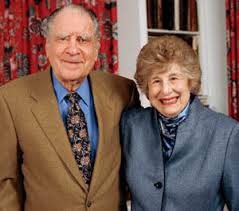 Eric and Evelyn met in 1938 and married the following year. Although nine years her senior, Eric found himself attracted to Evelyn’s
“enthusiasm and original ideas.” The two were partners in a variety of philanthropic endeavors, and Evelyn was a constant supporter of Eric’s
numismatic pursuits, hosting a steady stream of visitors to their home in Clayton, MO.
Eric and Evelyn met in 1938 and married the following year. Although nine years her senior, Eric found himself attracted to Evelyn’s
“enthusiasm and original ideas.” The two were partners in a variety of philanthropic endeavors, and Evelyn was a constant supporter of Eric’s
numismatic pursuits, hosting a steady stream of visitors to their home in Clayton, MO.
Evelyn inadvertently named Eric Newman and Ken Bressett’s 1962 book The Fantastic 1804 Dollar, first offering up “fantastic” in the context of the coin’s fame. Eric seized on the double meaning (unreal or absurd) and the book was so titled.
Like all spouses of numismatic writers, Evelyn lived amid piles of books and papers, but rather than suffer through ever-spiraling bibliophilic entropy (Eric himself admitted that he got involved in several numismatic projects for every one that got published), Evelyn turned the proverbial frog into a prince and launched the St. Louis Book Fair, which still thrives after sixty years and supports charities related to literacy and academic assistance for low-income children.
Eric and Evelyn traveled the world together, completely fascinated by how others live and dedicated to the idea of improving the world by forming connections at the most basic, personal level. These experiences informed their giving, which has focused on medical research, education, and the St. Louis cultural community.
 In the 1950s, there was something odd going on at the Newman household in Clayton. A chute was hooked up to a window near the driveway that
led into the basement. Every so often, a car pulled up to unload.
In the 1950s, there was something odd going on at the Newman household in Clayton. A chute was hooked up to a window near the driveway that
led into the basement. Every so often, a car pulled up to unload.
The goods turned out to be donated books — tons of them. Each pile needed to be sorted, priced for resale: five cents for most books, a dime for the nice ones, maybe $2 for a rare find.
“Then it got a little bit out of hand,” Andy Newman, recalling his childhood home, said of the operation. “It got very, very large. The house was always full of one project or another.”
The used book drive eventually became widely known as the Greater St. Louis Book Fair and a signature of Evelyn E. Newman, queen of the resale fundraiser.
The books supported St. Louis’ first interracial day care, but over decades of philanthropy, Mrs. Newman, a no-nonsense heiress to the now defunct Edison Brothers Stores Inc., was involved with all sorts of causes in St. Louis.
“She got things going and then she moved on to the next creative endeavor,” said Emily Pulitzer, who with Mrs. Newman and others was a founding director in 1980 of The First Street Forum, what is now Contemporary Art Museum St. Louis.
Mrs. Newman, of Clayton, died Tuesday (Sept. 1, 2015) at Barnes-Jewish Hospital after a brief illness, family said. She was 95.
She leaves behind a legacy of getting things done in the St. Louis culture and charity scene.
In 1960, she helped create a high-end used clothing store to support the Scholarship Foundation of St. Louis. Since then, ScholarShop stores in Webster Groves and Clayton generated about $23 million in interest-free loans and grants for college students, said Faith Sandler, executive director of the foundation.
“She really was the catalyst of founding the ScholarShop,” Sandler said. “It was her brainchild, her idea, her energy.”
In the 1980s, Mrs. Newman was the first executive director of Forest Park Forever, the nonprofit organization that has helped turn the park into one of the region’s biggest attractions.
“She was very, very important in our early years,” said Lesley Hoffarth, who now leads the group. “She really had attention to detail and fabulous ideas.”
Evelyn Edison Newman was born July 25, 1920, in Atlanta. Her family moved to St. Louis nine years later to be close to the country’s shoe manufacturing hub. The family business, Edison Brothers, grew into a publicly traded company that at its peak had 2,000 stores before ending in bankruptcy in 1995.
Mrs. Newman married Eric P. Newman in 1939. Eric Newman, 104, a retired lawyer for Edison Brothers Stores, is a rare coin and currency scholar and collector.
Auctions from his collection in recent years principally funded more than $60 million in donations to a foundation in the couple’s name to make grants mainly to St. Louis-based institutions.
At Washington University, the couple helped create the Eric P. Newman Education Center at the School of Medicine, several professorships, scholarship funds and the Newman Money Museum on campus.
To read the complete article, see:
Evelyn Newman: Queen of St. Louis fundraising has died
(www.stltoday.com/news/local/obituaries/evelyn-newman-queen-of-st-louis-fundraising-has-died/article_04e98817-3143-566e-beaf-e46c59e8dfc6.html)
Ten years ago, Mrs. Newman told the Washington University Magazine “I am an idea person. I love spotting trends and I have always been interested in retail because of my family.”
That family was the Edisons. The Edison Brothers and their shoe business, which went by a number of names, was founded in 1922 and moved from Georgia to St. Louis in 1929. It flourished in a town known for shoes and booze, and became a titan in the American shoe business. In the late 1940s, for example, it was the largest chain of women’s shoe stores in the country.
Mrs. Newman benefited from a good education and an interesting one. She graduated from John Burroughs School in 1937, attended Goucher College in Baltimore and Washington University as well. But her true alma mater, she always said, was the “University of Eric Newman.” He, as was she, is a very smart man indeed. He, at the age of 104, survives his wife.
 Throughout – in her personal life and in business – Mrs. Newman carried herself with warmth, grace and cultivated elegance. She was a woman
of exuberance and enormous energy too; in fact, right until the end, she seemed forever youthful -- so spry, so vigorous, so vital the family was
genuinely surprised she had died.
Throughout – in her personal life and in business – Mrs. Newman carried herself with warmth, grace and cultivated elegance. She was a woman
of exuberance and enormous energy too; in fact, right until the end, she seemed forever youthful -- so spry, so vigorous, so vital the family was
genuinely surprised she had died.
“Her spunk and with-it-ness disguised how old she was,” her son, Andrew Newman, said. “She was always reinventing herself – examining this concept or that concept.”
To read the complete article, see:
Evelyn
Edison Newman: Creative philanthropist made it fun for others to contribute
(http://news.stlpublicradio.org/post/evelyn-edison-newman-creative-philanthropist-made-it-fun-others-contribute#stream/0)
Ken Bressett writes:
I will always remember Evelyn for being as warm, friendly and hospitable as Eric in every respect. Although she had many of her own special interests and projects she was ever tolerant and supportive of Eric’s life-long dedication to numismatic education. They were perfectly blended in their humanitarian efforts to make the world a better place for all, and in this succeeded in ways far beyond what their modesty publicly admitted. Always the perfect hostess, Evelyn was always the star attraction for anyone visiting their home and will forever be treasured in my memory and by all who knew her.
Joel Orosz writes:
In the world of philanthropy, Evelyn was widely known for the creativity of her fund-raising ideas. The "Shirt off Your Back Ball" fundraiser, for example, sent donors home in plastic garbage bags, having given not only cash for the cause, but literally the clothes they wore to the event. Greater St. Louis benefited from decades of Evelyn's efforts to support education, healthcare, human services, arts and culture, religious charities and environmental programs. If ever there was anyone who left her world in a better state than she found it, that person was Evelyn Newman.
In the process of research for Eric's upcoming biography, no one could have been more zealous in protecting Eric from authors who overtaxed his energies by peppering him with questions for too long, but no one could have done it with more grace and kindness. If Evelyn was capable of acting in a mean or small-minded way , I could find no evidence of it. She made everyone she touched a little more humane, a little closer to their best selves. It was a privilege to know her.
Roger Burdette writes:
She was an exceptional person and a wonderful supporter of Eric and of her own charitable projects. St. Louis has lost one of its most imaginative lights.
To read the New York Times obituary, see:
EVELYN NEWMAN
(www.legacy.com/obituaries/nytimes/obituary.aspx?page=lifestory&pid=175746457)
GOBRECHT JOURNALS #1-120 NOW ONLINE

The LSCC is pleased to announce that back issues of the Gobrecht Journal (through issue #120 – July 2014) are now available online at https://archive.org/details/newmannumismatic (enter “Gobrecht Journal” in the search box).
While the Collective Volume series remains indispensable for quick access in hardcopy format, many collectors prefer online references. This project was accomplished at no cost to the LSCC by the Newman Numismatic Portal.
The Newman Portal, sponsored by the Eric P. Newman Numismatic Education Society and administered through Washington University in St. Louis, aims to capture the world’s numismatic in-formation, on a free and forever basis, within a single site.
The scanning center for the Newman Portal is located in Olin Library at Washington University. The Newman Portal then uses Internet Archive, a San Francisco company, as its document warehouse, to upload and host scanned documents. Scanned documents appear immediately on Internet Archive, and new documents are added daily.
In parallel, the Newman project is creating its own website, http://www.newmannumismaticportal.org.
This site will incorporate all of the scanned content in addition to electronic data, such as auction records. Users will be able to search across all of this material, creating a powerful search experience dedicated to the numismatic space. It should be noted that Internet Archive supports search within single documents only – so, although all previous Journals are now available online, it is not yet possible to search across the entire set at once. The Newman Portal, which will deliver this capability, will be open in 2016.
While back issues of the Journal are now online, there is no immediate plan to sup-port online subscriptions to the Gobrecht Journal, although the officers are certainly open to proposals in this regard.
The LSCC wishes to thank NNP Project Coordinator, Len Augsburger, for expediting the scanning of the Gobrecht Journal for public use and Steve Crain and Bill Bugert for loaning back issues of the Gobrecht Journal for use in this project. All small format Gobrecht Journals (Issues #1-120) now on-line!
For more information about the Liberty Seated Collectors Club, see:
www.lsccweb.org
To visit the Newman Numismatic Portal Facebook page, see:
https://www.facebook.com/newmannumismaticportal/
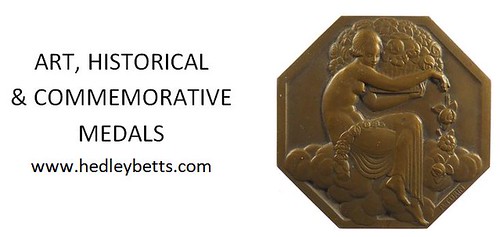
NOTES FROM E-SYLUM READERS: SEPTEMBER 6, 2015
Query: Source For Designer of the 1847 Hawaiian Cent
Julia Casey writes:
I read with interest Bill Groom’s submission about Edward Hulseman in last week’s edition of The E-Sylum. I have written an article about Edward Hulseman which is to be published in the August, 2015 issue of The Colonial Newsletter (CNL-158 The American Numismatic Society, Oliver D. Hoover, ed.). In my article I quote from and reprint the New York Morning Herald article referenced by Mr. Groom.
I also have some questions regarding the attribution of Hulseman as the designer of the 1847 Hawaiian Cent. From my research this connection began with Walter Breen (Walter Breen's Complete Encyclopedia of U.S. and Colonial Coins, 1988). Do the readers of The E-Sylum have any additional information about the source of this attribution?
To read the earlier E-Sylum article, see:
EDWARD HULSEMAN'S CATSKILL BANK COUNTERFEIT
(www.coinbooks.org/esylum_v18n35a21.html)
More on the Castorland Pieces
Dave Alexander writes:
The Castorland pieces were the subject of more speculation and false information than any other Colonial era issue. There is no evidence of any serious intent to circulate a coin in this desolate and remote frontier area. Most likely, these were "Jetons de Presence" given to the colony's Commissioners, meeting in far-off Paris to discuss progress of the colony. Most of the Commissioners fled during the Revolution, others were not "hung" as noted in the E-Sylum story but decapitated by the guillotine.
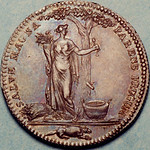 The crown worn by Ceres is not all that "unusual." It is what we call in heraldry a Mural Crown that was proper to city goddesses
and the occasional non-monarchical government such as the Second Spanish Republic of 1931-39. As to the late Bill Anton's description and pricing
for his purported original, it should be noted that he was never one to let inconvenient facts impede the flow of his narrative.
The crown worn by Ceres is not all that "unusual." It is what we call in heraldry a Mural Crown that was proper to city goddesses
and the occasional non-monarchical government such as the Second Spanish Republic of 1931-39. As to the late Bill Anton's description and pricing
for his purported original, it should be noted that he was never one to let inconvenient facts impede the flow of his narrative.
To read the earlier E-Sylum article, see:
QUERY: BRASS CASTORLAND MEDAL INFORMATION SOUGHT
(www.coinbooks.org/esylum_v18n35a14.html)
Early Reference to 'Leopold the Hogmouth'
Scott Miller writes:
I am sure this is not the earliest reference, but the Hogmouth is mentioned in the Coin Collector’s Journal, vol X, 1886. In “A Numismatic Tour of Europe” by Hector E. Kirkwood, an entry on p. 51 describing a coin of Leopold notes “This is the emperor who from a strange protrusion of the lower lip received the unenviable pseudonym of ‘hog-mouth’.” Obviously, this is not the earliest reference, but at least it is a starting point.
To read the earlier E-Sylum article, see:
To read the earlier E-Sylum articles, see:
BEST. ROYAL. NICKNAME. EVER. (www.coinbooks.org/esylum_v18n32a22.html)
NOTES FROM E-SYLUM READERS: AUGUST 16, 2015 : Was Hans Schulman Responsible for
'Hogmouth'? (www.coinbooks.org/esylum_v18n33a08.html)
NOTES FROM E-SYLUM READERS: AUGUST 23, 2015 : The Origin of 'Leopold the
Hogmouth' (www.coinbooks.org/esylum_v18n34a11.html)
Alan Weinberg on the Numismatic Antons
Alan V. Weinberg writes:
I knew Bill Anton Senior and Jr since 1959. Anton Senior was into real estate development and I worked for him at a construction site around summer 1961- I still have my "Anton scar" on my right wrist from putting my hand thru a window pane. Anton Sr. was a serious numismatist and is pictured in some photographs of mid-late 50's NY coin club dinners.
Bill Anton Jr,, very proud of his disappearing Assyrian ancestry, sold me my first colonial coin in 1960 at an Atlantic City boardwalk coin show. A blazing mint red thick flan God Preserve London elephant token for $600 when the going rate for brown Uncs was $100+. That started me in colonials and during my college years Bill and I talked often long distance on the phone and he'd mail me choice examples on approval of classic extremely rare colonial rarities like pattern Confederatios, usually in the range of $3,000. One summer when I was home from Ohio college Bill took me to a New Jersey restaurant and in candlelight he spread out SEVEN genuine Higley threepences, ranging from Good to Very Fine. I picked a nice, unmarred fine Axe Higley for $3750.
Bill Jr was a big friendly guy- he'd once been a champion bodybuilder in the 50's which he attributed to his stooped posture late in life due to early-on use of steroids (which was acceptable practice back then). But two stories can reveal two sides to his personality - much like our mutual friend John J. Ford, Jr.
In the early 60's a customer came into Howard Hazelcorn's 44th St NYC coin shop and sold Howard a "gem proof" 1776 Continental dollar, which were around back then in Gem Prooflike at approx $1200. The next day Howard showed it to me and priced it quite reasonably but I was hesitant due to the extraordinary quality and knowledge that restrikes of sorts existed. So I called my good friend and mentor Bill Jr and described it to him. "Don't buy it- it's a fake". The next day I learned from Howard that Bill visited Howard's shop and bought the coin.
On the opposite side of his personality: Bill and I had attended the December 1983 Stack's John Roper's magnificent colonial coin auction in New York City - Roper had often gone head to head with Don Partrick at auctions. Less than a week later in NYC Doyle Galleries' was auctioning Loye Lauder's splendid colonial coin collection ( Loye, sister of cosmetics baron Estee Lauder and their brother, a famed rare stamp collector ) . I wanted the mint state Lauder 1792 silver center cent, which I stopped by at Doyle to examine, but was unable to remain in NYC for that auction as I lived in Southern California. Bill offered to bid for me. I gave him a bid of $77,000 "all in". Doyle conducted the "Dutch auction" the following Wednesday and the 1792 pattern opened at the $70,000. estimate no bids. $60K, no bids, $50K no bids. $40K and Bill raised his arm. It was immediately hammered down to him with other prominent dealers at the auction caught sitting on their hands. "All in" $44K. Bill asked for a $200 check for his trouble - gas , parking, dinner, etc - so generous. He could have easily held me up for a lot more.
There are many more stories about both sides of Bill who, like JJF, had an almost split personality. I know Bill Jr's son Bill III fairly well and he's a serious numismatist. Bill Jr had magnificent American colonials , including the unique Garrett/JHU white metal 1792 Birch cent, great silver Indian Peace medals and other really rare American medals. He had previously sold his Puerto Rican currency and Alaska currency.
To read the earlier E-Sylum article, see:
MORE ON AUTHOR BILL ANTON, JR. (www.coinbooks.org/esylum_v18n34a18.html)
On Cleaning Verdigris From Copper Coins
Alan V. Weinberg writes:
This has been my belief and practice for decades on green corrosion spots:
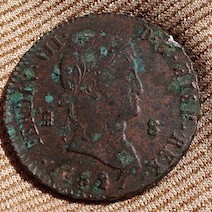 Bright green means the corrosion is still active. Dark green means the corrosion is stable and unlikely to spread further. For dark green,
I recommend a tiny drop of Coin Care (blotting the excess) on the green corrosion to prevent further oxidation. Attempted removal or reduction of the
crusty green corrosion will further impair the coin. On bright still-active corrosion, I use a pin head drop (actually use a pin head) of highly
diluted muriatic acid on the spot, monitoring its fizzing with a glass, blot it with a Q-tip and apply a drop of water w/baking soda on that spot,
rinse and blot dry. Green corrosion gone. In some cases the "green corrosion" is not at all corrosion but soft green "leather
wax" from storage in a leather pouch. That is easily removed with a Q-tip and Coin Care - and should be.
Bright green means the corrosion is still active. Dark green means the corrosion is stable and unlikely to spread further. For dark green,
I recommend a tiny drop of Coin Care (blotting the excess) on the green corrosion to prevent further oxidation. Attempted removal or reduction of the
crusty green corrosion will further impair the coin. On bright still-active corrosion, I use a pin head drop (actually use a pin head) of highly
diluted muriatic acid on the spot, monitoring its fizzing with a glass, blot it with a Q-tip and apply a drop of water w/baking soda on that spot,
rinse and blot dry. Green corrosion gone. In some cases the "green corrosion" is not at all corrosion but soft green "leather
wax" from storage in a leather pouch. That is easily removed with a Q-tip and Coin Care - and should be.
To read the earlier E-Sylum article, see:
ON CLEANING VERDIGRIS FROM COPPER COINS
(www.coinbooks.org/esylum_v18n35a20.html)
Turkey Coins on Amazon
Bob Leonard writes:
Regarding Amazon selling coins, not everything is certified and graded by NGC. Check this entry out.

To view the Amazon item, see:
Collectibles & Fine Art : Rare Coins : Turkey
To read the earlier E-Sylum article, see:
NOTES FROM E-SYLUM READERS: AUGUST 30, 2015 : Free Shipping For Six-Figure
Coins (www.coinbooks.org/esylum_v18n35a11.html)
Results of the Non-Caption Contest
In response to my "[insert your own caption here]" note last week, Chip Howell has risen to the occasion.
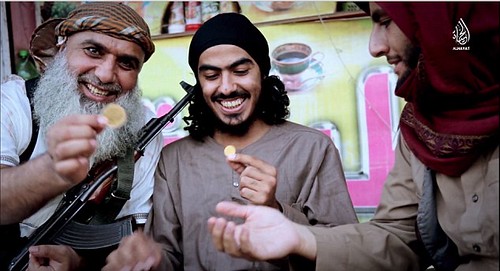
He writes:
1) Let's see them try to "Spock" these!
2) Remind me, Mahmoud--what does the tiny "V.D.B." mean?
3) Wow, that Amazon Prime same-day delivery really works!
4) And they said nothing good would come of all the looting & killing...
5) Great! Maybe now we can get that "magic fingers" machine in the motel to work!
6) You gotta admit, this is WAY better than the Susan B. Anthony Dirham.
7) Hope one of you brought some shears, 'cause that coffee's gonna set you back 1/64th of a dinar.
8) I love the way the mirrored background brings out the murderous glint in my eyes.
9) Hold it by the RIM--the RIM! Dammit, Ahmed, we can't have nice things!
10) NOW do you believe in the Tooth Fairy? See? It doesn't even have to be YOUR teeth, as long as you BELIEVE.
Chip adds:
What's funny to me is, these "Islamic" coins all bear names (dinar, dirham, fils/fulus) derived from pre-Islamic, European words. AND they use the decimal system: How "Age of Enlightenment" of them!
To read the earlier E-Sylum article, see:
ISIS VIDEO SHOWS GOLD DINARS BEING MINTED
(www.coinbooks.org/esylum_v18n35a25.html)
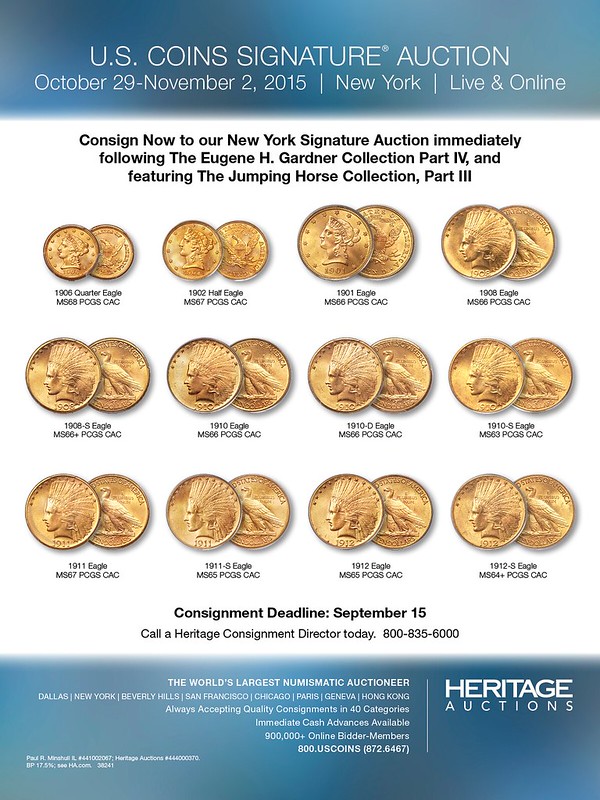
MEDAL COLLECTORS OF AMERICA SPECIAL OFFER
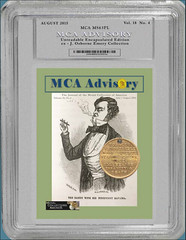 The most recent issue of the MCA Advisory, journal of the Medal Collectors of America, is jam-packed. After receiving the
July-August 2015 issue, the venerable Dave Bowers commented:
The most recent issue of the MCA Advisory, journal of the Medal Collectors of America, is jam-packed. After receiving the
July-August 2015 issue, the venerable Dave Bowers commented:
“Just finished SKIMMING this issue! Wow! Now, as usual, I will spend an hour or two digesting each word. . . Immersing in such stuff is intellectually stimulating, much if not most content is not available in any other single source, and numismatics and history are nicely merged . . . nicely done”
The issue contains a diversified group of detailed and insightful articles on historical and art medals, many written by award-winning numismatic authors:
- Musée Carnavalet – by John W. Adams
- The Clodion Terra Cotta Sculpture of the Libertas Americana Reverse – Tony J. Lopez
- The Duviviers- Chester L. Sullivan
- Reverend George Trask – Anne Bentley
- The Medal as Metaphor: Enduring Symbols – Marcy Leavitt Bourne
- A Look Alike or a Pisanello – Lev Tsitrin
- Book Review: Medallic Art of the American Numismatic Society by Scott H. Miller – David T. Alexander.
MCA is giving away a free electronic copy of the current issue of the MCA Advisory to all E-Sylum members. The MCA E-Advisory can be opened and viewed here: July August 2015 MCA E-Advisory (https://drive.google.com/file/d/0B5ABLMM43RQLN3VaYW0tcXhNVXM/view).
Medal Collectors of America is an ANA member club, founded in 1998 for collectors of historical and art medals. Last year, Dave Bowers praised the MCA and their Advisory in his blog:
“. . . the object of my attention is the Medal Collectors of America. Although I have been there and done that in American numismatics for nearly all of my life, and while I find medals one of the most interesting fields, each issue of the MCA Advisory contains information of which I knew little or nothing before.”
“This group, which publishes the MCA Advisory, is one of the most dynamic organizations to which I belong.”
MCA is now offering a special membership promotion for E-Sylum readers. We offer two types of membership: Electronic at $25 per year, and print at $55 per year. If you mention the E-Sylum promotion when you sign up and pay your first years dues, you will receive membership all the way through the end of 2016. The remaining 2015 issues of the MCA Advisory (print or by e-mail depending on the type of membership you pay for) will be free!
The MCA website is full of information and resources on the organization and medal collecting: www.medalcollectors.org .
The membership application can be found at the link below. Please print, complete, and forward the application to MCA Treasurer Barry D. Tayman at the address shown on the application. Remember to mention the E-Sylum promotion so your membership will be extended through the end of 2016:
MCA Membership Application (www.medalcollectors.org/Contacts/APPLICATION FORM-OCT-2011.pdf)
MORE ON THE SAINT-GAUDENS CORNISH MASQUE PLAQUETTE
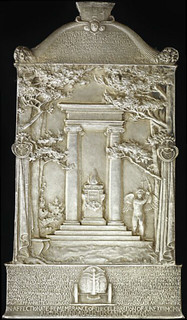 The Saint-Gaudens plaquette on the cover of the September issue of The Numismatist, illustrating Erik Goldstein's excellent
article. and the summation in last week's E-Sylum, is indeed a rare piece.
The Saint-Gaudens plaquette on the cover of the September issue of The Numismatist, illustrating Erik Goldstein's excellent
article. and the summation in last week's E-Sylum, is indeed a rare piece.
It may have been so rare that when a specimen came up for auction in a Hans M.F. Schulman sale it attracted the attention of Neil MacNeil (1923-2008), author of the book The Presidents Medal (1977). Neil had been appointed as one of the directors of the Saint-Gaudens National Historic Site in Cornish, New Hampshire a few years before.
Whether the museum at the site had one of these in their collection I do not know, but Neil bid and won the medal. He almost immediately donated it to the site. I know since I was the underbidder. The plaquette is illustrated in John Dryfout's 1982 book The Work of Augustus St-Gaudens.
For numismatists or book collectors Dryfout's book is a catalog raisonné of Saint-Gauden's medallic work. For even more on the subject of Saint-Gaudens involvement see Michael Moran's 2008 book Striking Change.
To read the earlier E-Sylum article, see:
THE SAINT-GAUDENS CORNISH MASQUE PLAQUETTE
(www.coinbooks.org/esylum_v18n35a17.html)
CHARLES N. BODEY (1834-1904)
Charles N. Bodey (1834-1904), was born of a prominent family, son of Benjamin (1799-1849), and Mary Magdalena Heffley Bodey (1800-1877), on September 16, 1834 in either Norwegian or Manheim, Schuylkill County, Pennsylvania. He lived his adult life in Orwigsburg, Schuylkill Haven, Pennsylvania. In 1855 he was awarded a diploma from the Pennsylvania State Agricultural Society for manufacturing a cushioned rocking chair. In 1857 he married to Nydia E. Bodey (1836-1914) and they had two children, Preston M. (1859-), and Grace E. (1862-).
He served for the Union Army Company C-138th Pennsylvania Volunteers during the Civil War.
Sometime prior to 1871 he was cured of a rupture by a famous traveling medicine man named Dr. Ferrard, heralded as the “Old Rocky Mountain Cancer King”.
Ebenezer Locke Mason, Jr., went with William Fewsmith, and Warner to buy his coin collection in 1867 but Bodey refused to sell. Mason was thrown from the wagon as they were departing and was seriously injured. Five years later he sold his coin collection at auction through John W. Haseltine (5th sale) on October 29-30, 1872.
In 1874, a notice ran in the Harrisburg Telegraph that he owned a silver Jewish shekel minted in 335 and worth 62 cents.
He was a cabinet and piano maker by profession. A small notice published in the Pittsburg Commercial, Wednesday, March 15, 1876 reported that the editor of the Orwigsburg Times had seen a miniature piano made by Bodey out of walnut shells.
In 1880, he was reported to own a Bible printed in 1755. Beginning in 1895 his business collateral describes him as an Undertaker, Grandfather Clock Dealer, and all kinds of Indian Relics. But, he also dealt in coins. He was an active client of the Chapman Brothers buying coins and curiosities.
In 1888, Robert W. Mercer, the coin and curio dealer in Cincinnati, Ohio, accused him of selling fake Indian relics, particularly flint arrowheads.
In the 1890’s he was the chief burgess of Orwigsburg and refused to sign the rules and regulations of the Board of Health. The town took him to court to force him to sign.
He was murdered by his son Preston, a rural mail carrier, during an argument over his last will and testament dated October 8, 1904, in which he left his son only $5. His son hit him over the head with a coal bucket causing a fatal wound and blood poisoning on December 30, 1904. The son was acquitted after a three-day trial by the testimony of his mother, who attested that his father struck him first with a shovel. His daughter Grace was left the entire collection of coins and curiosities.
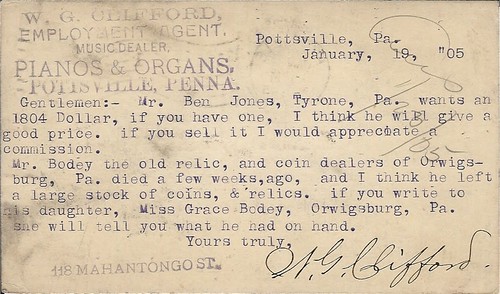
William G. Clifford's (1863-1907) postal card to the Chapman Brothers, postmarked January 21, 1905.
"Gentlemen : Mr. Ben Jones, Tyrone, Pa. wants an 1804 Dollar, if you have one, I think he will give a good price. If you sell it I would appreciate a commission.
"Mr. Bodey the old relic, and coin dealer of Orwigsburg, Pa. died a few weeks ago, and I think he left a large stock of coins, & relics. If you write to his daughter, Miss Grace Bodey, Orwigsburg, Pa. she will tell you what he had on hand.
"Yours truly, W. G. Clifford."
John Lupia adds:
The death announcement by a postal card sent to the Chapman Brothers is fascinating since it begins with a client feeling out if they have an 1804 Dollar for sale and if they do he has a buyer and would like a piece of the pie.
To read the complete article, see:
BODEY, CHARLES
N. (https://sites.google.com/site/numismaticmallcom/encyclopedic-dictionary-of-numismatic-biographies/bodey-charles-n)
MORE ON WILLIAM WEEKS
David Gladfelter writes:
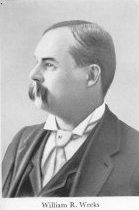 Here is the photo of William Weeks published in Howard L. Adelson’s 1958 book, The American Numismatic Society, 1858-1958.
Here is the photo of William Weeks published in Howard L. Adelson’s 1958 book, The American Numismatic Society, 1858-1958.
Strangely, Adelson mentions nothing of John Lupia’s story of Weeks’s arrest and imprisonment, but John M. Kleeberg does in his 2009 centennial history of the New York Numismatic Club, titled An Island of Civility. Per Kleeberg: “Around 1897 Weeks [not yet a NYNC member] was entrusted with the settlement of the Edward Lister estate. He expected a fee of $70,000 from the settlement of the estate. Moreover, the estate made him president of the Lister Agricultural Chemical Company, at a salary of $8,000. However, a series of events in which he plundered the assets of the Lister Estate and the Plaut Trust, led to his arrest[, conviction] and imprisonment.”
As a result of these defalcations Weeks was forced to resign from a patriotic organization to which he belonged, but he retained membership in ANS and was actually admitted to membership in NYNC in 1909 and 1910. Kleeberg’s comment: “Yet the numismatic world remained oblivious to these events. … Yet Weeks’s elite social background exempted him from penalties that would have destroyed a less well-connected lawyer’s career. Despite Weeks’s thefts from his clients, he continued to practice law until his death in 1919.” Today such conduct would merit certain disbarment in any jurisdiction.
There is a 1-1/2 page bio of Weeks in John Whitehead’s The Judicial and Civil History of New Jersey published in 1897 before Weeks’s career-tarnishing events occurred. This bio lists Weeks’s membership in 13 professional, civic and fraternal organizations, including ANS. It cites several historical publications by Weeks, including History of the American Numismatic and Archaeological Society, with Lists of its Founders, Incorporators, Officers and Members (1892).

John Kleeberg writes:
William Weeks did not attend the 1913 dinner meeting of the New York Numismatic Club. He had resigned from the Club on June 16, 1910, giving as his ostensible reason that he was moving out of New York City. He attended and was photographed at the regular meeting of November 12, 1909. He appears at the extreme right, cropped so that only part of his head is visible.
This photograph has many eminent numismatists in it, both reputable (Victor D. Brenner, Wayte Raymond, William Woodin, Frank Higgins, John Clapp) and disreputable (Stephen K. Nagy, William Weeks).
John Lupia writes:
I just looked up the other William Weeks in my Encyclopedic Dictionary of Numismatic Biographies and found the entry and bibliography. The term billembiques was first published by the New York Times and reprinted in an articles titled “A Weird Monetary Muddle,” (reprint from the New York Times) The Numismatist, October (1915) : 376
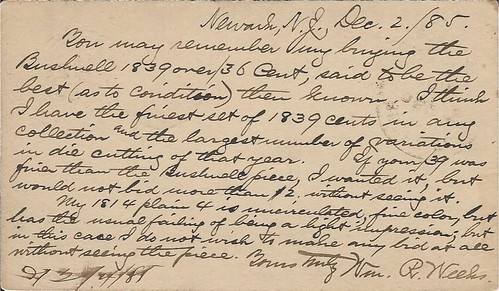
Postal Card discussing anticipated bids on the Chapman coin auction held December 15-16, 1885:
"You may remember my buying the Bushnell 1839 over/36 Cent, said to be the best (as to condition) then known. I think I have the finest set of 1839 cents in any collection and the largest number of variations in die cutting of that year. If your /39 was finer than the Bushnell piece, I wanted it, but would not bid more than $2; without seeing it.
"My 1814 plain 4 is uncirculated, fine color, but has the usual failing of being a light impression; but in this case I do not wish to make any bid at all without seeing the piece. Yours truly Wm. R. Weeks."
John Lupia writes:
It might be beneficial for readers to be aware that whatever Chapman mail I post in these biographies is not everything in the archive, but rather, merely the piece or pieces I happen to come across at the time. I know there is more material on the person I am writing about in my collection. Unfortunately I have not completed a full digital catalogue allowing everything to be retrieved in a single search. Only about 8 per cent is catalogued this way. I came across the extra material on Weeks by chance and thought it was worth posting since it reveals his collecting areas of interest and the snafu the Chapmans ran into mailing an auction catalogue at the proverbial eleventh hour.
To read the earlier E-Sylum articles, see:
FIRST NEW YORK NUMISMATIC CLUB MEETING PHOTO
(www.coinbooks.org/esylum_v12n25a18.html)
MORE ON WILLIAM WEEKS (www.coinbooks.org/esylum_v18n35a12.html)
THE BOOK BAZARRE
NUMISMATIC WORD USAGE OVER TIME
Len Augsburger writes:
The ever-inventive folks at Google have charts that show word usage over time. I tried “uncirculated” and the resulting graph parallels the growth of numismatics in the 1960s, leading up to the precious metals collapse in 1980. “Overdate” suggests an initial burst of interest in the 1930s – perhaps related to Wayte Raymond’s launch of the Standard Catalog in 1934? The great “cent” vs. “penny” debate can also be settled – while “cent” may be the legally correct term, public usage of “penny” shows an uptick while “cent” trends downward since the 1940s. A few more obscure terms gave no results – Google apparently limits these charts to terms with sufficient use for statistical purposes.

Uncirculated

Overdate

Penny

Cent
To view the definition and graph of 'Uncirculated', see:
https://www.google.com/#q=uncirculated+definition
LECTURE: RESTORING THE JACOB PERKINS BUILDING
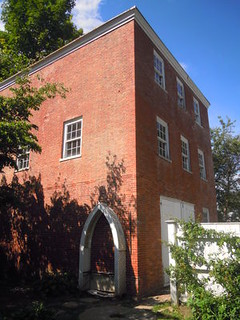 We will hold our 138th Annual Meeting next Wednesday, September 9. Join us in the Perkins Mint and hear about its brick restoration,
completed by Richard Irons Restoration Masons this summer. Richard will talk about his work restoring this veritable brick fortress where
Massachusetts money was printed in the 19th century. Afterwards, enjoy a reception with fellow Old Newbury members.
We will hold our 138th Annual Meeting next Wednesday, September 9. Join us in the Perkins Mint and hear about its brick restoration,
completed by Richard Irons Restoration Masons this summer. Richard will talk about his work restoring this veritable brick fortress where
Massachusetts money was printed in the 19th century. Afterwards, enjoy a reception with fellow Old Newbury members.
For the past forty years, Richard Irons has worked on and documented period brick and stone structures from foundation to finial. Along the way, he has also restored forgotten practices of the mason's craft and become a leading practitioner in his field. Through hard-earned experience, he has developed trade standards for investigation, preservation and reconstruction of masonry elements.
Membership Meeting-6:00pm
"Brick by Brick" Program with Richard Irons-6:30pm
Reception-7:00pm
RSVP to info@newburyhistory.org or 978-462-2681
To read the complete article, see:
138th Annual Meeting: Brick by Brick
(www.newburyhistory.org/calendar/2015/9/9/138th-annual-meeting-brick-by-brick)

CHARLES BARBER CORRESPONDENCE ARCHIVE
 The August 2015 issue of the newsletter of the Cuban Numismatic Association reprints an undated article by David Ganz on archival materials
of U.S. Mint engraver Charles Barber, which includes some good information on Barber's Cuban coin designs. The correspondence archive is housed
at the National Numismatic Collection at the Smithsonian, with copies at the American Numismatic Association library. -Editor
The August 2015 issue of the newsletter of the Cuban Numismatic Association reprints an undated article by David Ganz on archival materials
of U.S. Mint engraver Charles Barber, which includes some good information on Barber's Cuban coin designs. The correspondence archive is housed
at the National Numismatic Collection at the Smithsonian, with copies at the American Numismatic Association library. -Editor
Mr. Frank Putrow, our past President, supplied the following article on Charles Barber written by Mr. David L. Ganz some time ago. It is not common knowledge among Cuban numismatic collectors that Charles Barber, Chief Engraver for the U.S.A. Philadelphia Mint, was the engraver of the first Cuban coinage in 1915. This timely article should represent a tribute to Charles Barber on the Centennial of Cuban coinage.
CHARLES BARBER : Artist Extraordinaire
Coins are often identified by the type of design (the Liberty quarter), the theme (buffalo nickel), metallic composition (1943 steel cent), or even size (large cent). But a few coins have received immortality for the artist who created them. More than any other artist, this distinctive tribute is associated with Charles Barber, whose Barber dime, Barber quarter, and Barber half are the stuff of great numismatic collections, and whose V-nickel includes the 1913 Liberty nickel rarity. His patterns are the stuff of numismatic legend. All are widely collected.
Charles Edward Barber was a prolific artist. His governmental career spans an incredible 12 presidential administrations and 48 years of government service. Starting in 1869 as an engraver's assistant - when Andrew Johnson was president - and ending during the second term of President Woodrow Wilson as chief engraver of the United States, Charles Barber probably designed, and engraved, more coins and medals than any other person in the employ of the United States or any other Mint, before or since. His tenure as Chief Engraver, 1880 to 1917, one of the Mint's longest, also coincided with fundamental changes in the national coinage system, starting with the enactment of the Coinage Act of 1873. It is a rare tribute that the work of a sculptor or engraver of coinage has his work stand the test of time, but in Barber's case, nearly 70 years after he died, his coinage designs were still being produced for circulation. (The Cuban 2 centavos coin, bearing his design, was still in production as late as 1986).
Charles Barber was also a chronicler of his life and times, an inveterate saver of correspondence that he received and copies of letters sent by him. He was a collector who saved examples of the coins that he created, and the patterns that he designed - together with examples of the work of others. Several years ago, in November, 1991, the Library and Museum of the American Numismatic Association received an extraordinary gift consisting of copies of the personal papers of Charles Barber, covering his term as sixth chief engraver of the United States Mint at Philadelphia. The originals were deposited at the Smithsonian Institution, but a complete set of the papers (which are about three inches thick) were presented to the ANA Library with the caveat that they could not be written about by scholars, or others, for a period of three years. That caveat has long since expired, and the papers have opened a depth of previously undisclosed knowledge about Barber and the coins he created. Covering coinage of the United States and many foreign countries, medallic works by the artist, and his extraordinary collection of numismatic pattern pieces, the journals are a rare opportunity to look to the past, and learn about the future. Barber's papers include handwritten correspondence, typescripts, and many design sketches for various coins. It also has information that is bound to make some changes in the way he is viewed as an artist, as well as in how his works are collected.
In reading through the notebooks, I was struck by how this material has yet to be mined by numismatic researchers. Barber maintained two small notebooks in which he listed the coins and medals that he owned - many of which he had engraved himself. It turns out that Barber was a collector not just of materials that he created, but of other artists such as Augustus Saint- Gaudens. Portions of the contents turn certain numismatic truisms on their ear. For example, the "Red Book" lists the mintage for the 1907 wire rim with periods $10 gold piece as 500 specimens, and the 1907 round rim periods before and after E Pluribus Unum as 42 pieces (noting that 19,958 were melted). Barber's notebook suggests that 50 pieces were made of the one, and his notebook states as to the other "only 550 made." Each is relatively scarce, but it would appear that this is based on availability or survivability, not just mintage.
Considerable source material is found on coinage of Cuba, covering a relatively short period of time (1914-15), but one in which there was considerable activity, for in 1915, the U.S. Mint produced 39.6 million coins for Cuba in denominations as low as one centavo to as high as 20 pesos in gold. Traditional sources credit a Cuban engineer, E.I. Montoulieu, with sheparding through the new Cuban coinage program. The Barber papers reveal otherwise. Montoulieu did become involved, but not until months after Charles A. Conant of 32 Liberty Street, New York City, wrote to Barber advising that he had been engaged by the Cuban government to "aid them in carrying out the coinage measure which became law on October 29th last." "I understand the government of Cuba desires the coinage as soon as possible," Barber wrote to Conant in early December, 1914, adding that "we have made the dies for coinage for almost all the Central and South American countries... [and] therefore can claim a pretty wide experience in this line."
A December 10, 1914 letter from Barber to Conant requested "to have for approval designs made for each coin with the required inscriptions, insignia and emblems displayed in a satisfactory manner." Barber focused on the diameter, "the relative in size one coin shall bear to the other, considering always the mechanical requirements for successful coinage." Barber advised that he would use a technique involving an engraved matrix "of both obverse and reverse of each coin", and that to facilitate "reproduction of the dies and decrease the cost of coinage what is technically called in this country a hub and by the French a "poincon" is made from the matrix."
For reasons of cost, the Cuban government initially contemplated issuance of several denominations only - just over half of the 13 units authorized under the new coinage law. All, however, were made that year, the first by Barber "for any one of the coins named two months after all detail consisting of design, diameter and everything necessary for the successful execution of the work is agreed upon and fixed." The fee: $3,000 for the first seven; then $400 apiece for the next six. While Barber executed the dies, Eduardo I. Montoulieu, "specially attached to the Monetary Commission" according to Conant's letter of December 24, 1914, prepared the actual drawings. But even here Barber has influence.
Two sketches were also submitted for the portrait of Marti on the five and 20 gold pesos: one draped, the other undraped. Barber also advocated either a reeded edge or a border, because "it would be unsatisfactory" not to have it and would leave the coin "bare, bald looking raw and unfinished." Many years later, the Cuban gold 10 pesos of 1916 was displayed at the 838th meeting of the Rochester Numismatic Association by John Jay Pittman, a past president of the American Numismatic Association, but in 1950, just beginning his career. The companion Cuban 1915 gold proof was shown by Pittman in January, 1951.
The material in the archive captures the professional lifetime of Barber. Among the earliest documents is a letter from Mint director H.R. Linderman, dated July 21, 1876, whose salutation begins "Dear Charley", and congratulates him on the bronze head of Col. James Fair, who later became U.S. Senator from Nevada. At the time, Barber had been his father's assistant for a scant seven years. His father, William Barber, preceded him as chief engraver. One of the last, written less than six months before his sudden death at age 77 on Feb. 18, 1917, is correspondence received from Adolph Alexander Weinman, the New York City sculptor who was then working on the Winged head (Mercury) dime design. As the late Leonard Forrer wrote in his book on medallic artists, Barber "was appointed an assistant in 1869 and became the official head by promotion in 1880, to fill the vacancy caused by his father's death. The appointment was not unmerited. Mr. Barber's five cent piece is a successful venture in very low relief. His handiwork is more or less visible in all principal medals executed since 1869..." Barber's design style was distinctive. His use of a classical styled head was noted by Professor Vermeule: "This Greco- Roman restyling of a Greek head of the 4th century B.C. was on display at the Philadelphia Academy of Art when Charles Barber, George T. Morgan and other artists of the Mint in the period from the Civil War to the First World War admired it and turned its full, grave if not heavy profile into designs for coinage."
I checked with David Ganz, who writes:
"The Item in question comes from The Barber Papers, a significant body of original documentation the originals of which were donated by Stack’s to the Smithsonian. I was ANA vice president at the time and as chairman of the Endowment Committee, I helped secure a copy of the Barber Papers for the ANA Museum.
"The article covers a lot more than the Cuban collection (which is significant). The most scholarly article was done for The Numismatist, It ran in February 1995 (starting page 170). This September, I celebrate my 6th decade writing about coins and numismatics."
For more information on the Cuban Numismatic Association, see:
http://cubanumis.com/
To read the earlier E-Sylum article, see: THE PAPERS OF CHIEF ENGRAVER CHARLES EDWARD BARBER (www.coinbooks.org/esylum_v13n17a11.html)
HENRY VOIGT’S SURETY BOND
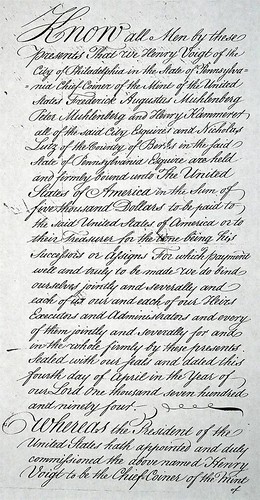
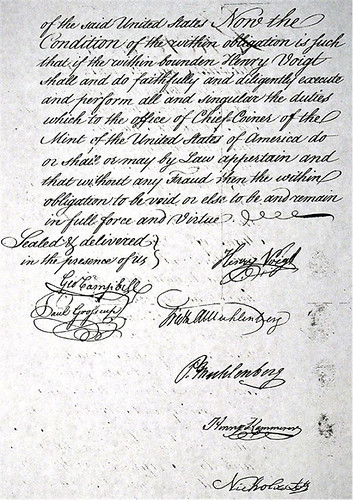
As a researcher of the technology, processes, implementation standards, and people that worked at the first United States Mint, I have read many publications on a wide variety of Mint related subjects. The general belief, without any supporting evidence, has long been that David Rittenhouse (the first Director of the Mint) posted the surety bond for Henry Voigt (the first Chief Coiner of the Mint). We now know that David Rittenhouse did not post Voigt’s surety bond. Voigt’s surety bond has been found, stored among Treasury Department documents for the last 221 years. It is being presented in this article for the first time ever.
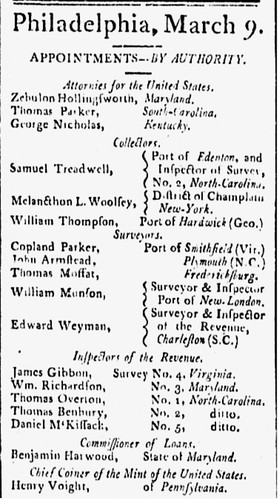 Henry Voigt was nominated as the first Chief Coiner of the United States Mint by President Washington on January 28, 1793. Congress
approved his nomination on January 29, 1793. He was announced as Chief Coiner 15 times in 4 different Philadelphia newspapers between March 9, 1793
and April 13, 1793. All 15 announcements incorrectly spelled his last name “V o i g h t”.
Henry Voigt was nominated as the first Chief Coiner of the United States Mint by President Washington on January 28, 1793. Congress
approved his nomination on January 29, 1793. He was announced as Chief Coiner 15 times in 4 different Philadelphia newspapers between March 9, 1793
and April 13, 1793. All 15 announcements incorrectly spelled his last name “V o i g h t”.
The Mint & Coinage Act of April 2, 1792 required the Chief Coiner to be bound to the United States of America and to post a surety bond of $10,000.00. This sum was too large for Voigt and he was unable to post his bond. This issue was one of the impediments to converting silver and gold bullion into coins during 1793 and most of 1794. Without the required bond in place, Voigt was unable to receive custody of silver and gold bullion. As a result, the employees in his department could not roll the bullion into strips, punch planchets out of the strips, process the planchets through the Castaing Machine (if required), and strike the planchets into United States money.
On December 30, 1793, Secretary of State Thomas Jefferson wrote a two page letter to President Washington identifying issues with The Mint & Coinage Act that prevented the Mint from accepting bullion deposits, and striking silver and gold coins. Per the first sentence, Jefferson’s letter was based on information provided by Director of the Mint David Rittenhouse:
“I am informed, by the Director of the Mint, that an impediment has arisen to the coinage of the precious Metals, which it is my Duty to lay before you”.
Jefferson’s letter also included the following passages:
“It will be recollected… That thereupon, our minister at London, according to the instructions he had received, endeavored to procure, there, a Chief Coiner and Assayer; That, as to the latter, he succeeded, sending over a Mr Albion Coxe, for that Office, but that he could procure no person, there, more qualified to discharge the duties of chief Coiner, than might be had here; and therefore did not engage one. The Duties of this last Office, have consequently been hitherto performed, and well performed by Henry Voight, an Artist of the United States: but the law requiring these Officers to give a security in the sum of 10,000 dollars each, neither is able to do it”.
“… The other alternative would be to lessen the Securityship in money, and to confide that it will be supplied by the vigilance of the Director, …”
On December 31, 1793, President Washington forwarded Jefferson’s letter to Congress. On February 18, 1794 the Senate passed a bill entitled "an act in alteration of the act establishing a mint and regulating the coins of the United States” or The Alteration of the Mint Act. The bill was approved by the House of Representatives on February 25th and signed into law by President Washington on March 3, 1794. Per Section 2 of The Alteration of the Mint Act, the Chief Coiner’s surety bond was reduced from $10,000.00 to $5,000.00:
“And be it further enacted, That the assayer and chief coiner of the mint previous to entering upon the execution of their respective offices shall each become bound to the United States of America with one or more sureties to the satisfaction of the Secretary of the Treasury, the said assayer in the sum of one thousand dollars and the said chief coiner in the sum of five thousand dollars, …“
Recall that in his December 30, 1793 letter, Thomas Jefferson stated, “The other alternative would be to lessen the Securityship in money, and to confide that it will be supplied by the vigilance of the Director”. If one were to ignore the words “the vigilance of”, the phrase would become “that it will be supplied by the Director”. I have found no other contemporary document that references Henry Voigt’s surety bond, therefore I believe that Thomas Jefferson’s statement may have been misinterpreted, resulting in the belief that David Rittenhouse posted Voigt’s surety bond.
The fact is, Henry Voigt’s surety bond was posted on April 4, 1794 by Frederick Augustus Muhlenberg, Peter Muhlenberg, Henry Kammerer, and Nicholas Lutz. When Voigt’s surety bond was posted:
- Frederick Augustus Muhlenberg was the Speaker of the United States House of Representatives,
- Peter Muhlenberg was a member of the U.S. House of Representatives from Pennsylvania’s at-large district,
- Henry Kammerer was a Philadelphia paper manufacturer, and a member of the Pennsylvania House of Representatives (representing Philadelphia City), and
- Nicholas Lutz was also a member of the Pennsylvania House of Representatives (representing Berks County).
Accurate information regarding Henry Voigt’s surety bond is now correctly documented for future generations of numismatists and numismatic researchers.
References
1. American State Papers; The Mint & Coinage Act of April 2, 1792 and The Alteration of the Mint Act of March 3, 1794.
2. Founders Online; www.founders.archives.gov, The Thomas Jefferson Papers.
3. National Archives and Records Administration; Treasury Department, Records of the Bureau of Accounts.
THE BOOK BAZARRE
MACOMB BATTLE OF PLATTSBURGH GOLD MEDAL OFFERED
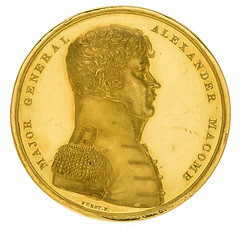
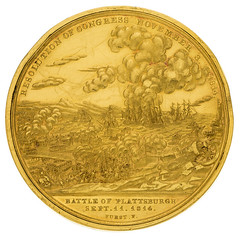
Gold medal in honor of Major General Alexander Macomb (1782-1841) presented by the President of the United States at the request of Congress, produced by the United States mint, commemorating its action at the Battle of Plattsburgh September 11 1814. The obverse shows the bust of Major General Alexander Macomb wearing his military uniform. The reverse shows a view of the Battle of Plattsburgh with troops crossing the Saranac River on the 1st level, then the fortifications with the city of Plattsburgh in flames, and finally left the naval battle in progress, diam: 6.4 cm, 248g
US military hero, named Commanding General of the US Army, he was acclaimed "The Hero of Plattsburgh" after the stunning victory of the Battle of Plattsburgh. Born April 3, 1782, son of a military brilliant, he began his career in the New York Rangers in 1798. He graduated from the Military Academy in 1802, he was successively promoted to Captain, Major, Lieutenant Colonel, Adjutant General, Brigadier and Major General in 1819, and General Commander of the Armed in 1828.
Below is some more information on Macomb from the National Museum of the United States Army. -Editor
Alexander Macomb was born in Detroit, on 3 April 1782. He moved to New York and was educated in Newark, New Jersey. When he was 16, he enlisted in the New York militia. He was commissioned a cornet in the Regular Army in 1799. Macomb left the Army for two years, and then became a second lieutenant in 1801.
Macomb became one of the first soldiers at the United States Military Academy when he was commissioned a first lieutenant in the Corps of Engineers, which had been created in 1802. He married Catharine Macomb, a cousin, in 1803. By 1810, he was a lieutenant colonel and served as chief engineer in charge of coastal fortifications in Georgia and the Carolinas. In 1812, he briefly served as acting adjutant general before he was promoted to colonel.
In the War of 1812, Macomb commanded troops at Sackett’s Harbor, the capture of Fort George and the St. Lawrence campaign. In 1814, he became a brigadier general before defeating the British at Plattsburg, New York. The action in Plattsburg earned Macomb a brevet major general rank and a gold medal from Congress.
To read the complete lot description (in French), see:
Détail du lot n° 1052 (http://hoteldesventes.ch/1052-44)
To read the Macomb article, see:
Major General Alexander Macomb
(https://armyhistory.org/major-general-alexander-macomb/)
To read Kraljevich's comments, see:
1814 Major
General Alexander Macomb Battle of Plattsburgh medal. Bronze, 65 mm. Julian MI-16. Choice About Uncirculated.
(www.jkamericana.com/1814-major-general-alexander-macomb-battle-of-plattsburgh-medal-julian-mi-16#.Ver58BG6dhE)


For other lot descriptions, see:
http://hoteldesventes.ch/fr/ventes/vente-principale?sale=44&vacation=342&mode=list#top
NUMISTORICA.COM
 Longtime noted numismatist Robert Korver has announced the launch of his new website, NumiStorica.com, a site devoted to the amazing tales,
interesting connections and fascinating characters that make numismatics such compelling hobby. Using his keen sense of synchronicity, parallels and
correlation, Korver brings to life his diverse subjects with a lively spirit.
Longtime noted numismatist Robert Korver has announced the launch of his new website, NumiStorica.com, a site devoted to the amazing tales,
interesting connections and fascinating characters that make numismatics such compelling hobby. Using his keen sense of synchronicity, parallels and
correlation, Korver brings to life his diverse subjects with a lively spirit.
“NumiStorica.com was created to provide free entertainment and education for coin clubs and advanced numismatists,” said Bob Korver. “After 50 years in the hobby and business – and after working at places like the Smithsonian and Colonial Williamsburg – I had a few stories worth sharing. My friends would also be quick to add that, perhaps, an opinion or two, as well.”
The site was awarded the Numismatic Literary Guild’s Best Non-Commercial Website award at the Summer ANA Convention in Chicago in August of this year.
The site currently has three slide shows and a half dozen articles posted. Many more will be posted during the coming months.
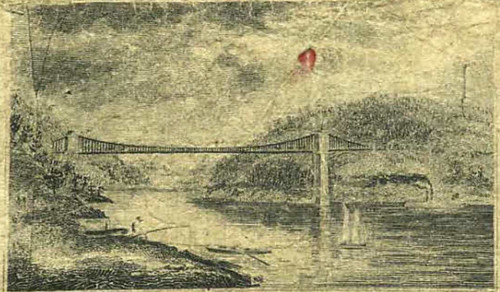
"A NIAGARA BRIDGE? Researching a Common Bridge Separating Two Peoples" is a 25-minute Keynote (Apple) slide show of how Korver does his research. The topic started simply enough: Was a bridge vignette on an Obsolete banknote generic, or unique? Confusion over more than 12 bridges yielded an astonishing conclusion (soon to be tested). If you have ever made numismatic assumptions and had them go bad, you should enjoy watching.
To visit the web site, see:
www.numistorica.com
To view the complete presentation, see:
"A NIAGARA BRIDGE? Researching a Common Bridge Separating Two
Peoples" (www.numistorica.com/a-niagara-bridge-.html)
To read the Coin World article, see:
Noted
numismatist Robert Korver creates Numistorica.com
(www.coinworld.com/news/us-coins/2015/09/noted-numistmatist-robert-korver-creates-numistorica-dot-com.html)
THE BOOK BAZARRE
MAJOR AWARDS FOR KAMPMANN AND PELLETIER
Ursula Kampmann
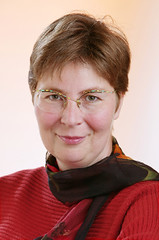 Ursula Kampmann is the 2015 recipient of the prestigious Burnett Anderson Memorial Award for Excellence in Numismatic Writing. This award
is presented annually to an author, journalist or researcher in recognition of their career contributions to the hobby. The award is sponsored by F&W
Publications, and the winner is selected in a cooperative process by the American Numismatic Association, the American Numismatic Society and the
Numismatic Literary Guild. Kampmann will be honored at the ANS Gala on Thursday, January 7, 2016 in New York City.
Ursula Kampmann is the 2015 recipient of the prestigious Burnett Anderson Memorial Award for Excellence in Numismatic Writing. This award
is presented annually to an author, journalist or researcher in recognition of their career contributions to the hobby. The award is sponsored by F&W
Publications, and the winner is selected in a cooperative process by the American Numismatic Association, the American Numismatic Society and the
Numismatic Literary Guild. Kampmann will be honored at the ANS Gala on Thursday, January 7, 2016 in New York City.
Ursula Kampmann was born in 1964 and has called Munich, Germany home for many years. Kampmann studied ancient history and numismatics as well as prehistory and medieval history at the Ludwigs-Maximmilians University in Munich and at the Universität des Saarlandes in Saarbrücken, Germany. After working as a professional numismatist for the Giessener Münzhandlung in Munich and the Münzen und Medaillen AG in Basel, Switzerland, she worked as chief editor for the German numismatic publication MünzenRevue (CoinsRevue) from 1996-2012.
In 2009 Kampmann founded MünzenWoche, and currently serves as the publication’s Editor-at-large and CEO. Kampmann has also been the Editor-in-chief for Mint News Quarterly, a journal that specializes in modern production technique of commemorative and circulating coins, since 2012.
Over the last 20 years, Kampmann has written more than 2,000 articles for notable publications such as: The Celator, Coin-News and Coin World (United States), and Cronaca Numismatica (Italy). Her writings have been translated into over 12 languages.
The CoinsWeekly team is very happy to see that Kampmann’s contributions have gained so much attention outside Germany, thanks to the internationality of CoinsWeekly. Ursula Kampmann states: “I have constructed CoinsWeekly as a bridge, a bridge connecting collectors, dealers, scholars and coin producers, but likewise nations as well as continents. To me, the award is proof that this concept works out. I have been writing articles for years, but it is only after CoinsWeekly came into being that they are recognized abroad as well. Thus, I am not only proud of being awarded such a prestigious honor but I am delighted at the success of CoinsWeekly. After all, I am the first European who has gained attention in the US with her numismatic writings. And we are having so many excellent numismatic authors here!”
To read the complete article, see:
ANA announces: Ursula Kampmann to receive the 2015 Burnett Anderson Award
(http://coinsweekly.com/en/News/4?&id=3631)
Serge Pelletier
 Serge Pelletier, who contributes to CoinsWeekly from time to time, received some lofty and well-deserved recognition during the
awards banquet at the 62nd annual convention of the Royal Canadian Numismatic Association (RCNA) held in Halifax, Nova Scotia, on July 22-26, 2015.
Pelletier received the J. Douglas Ferguson Award, the highest numismatic honour in Canada, presented for “distinguished service to Canadian
numismatics.”
Serge Pelletier, who contributes to CoinsWeekly from time to time, received some lofty and well-deserved recognition during the
awards banquet at the 62nd annual convention of the Royal Canadian Numismatic Association (RCNA) held in Halifax, Nova Scotia, on July 22-26, 2015.
Pelletier received the J. Douglas Ferguson Award, the highest numismatic honour in Canada, presented for “distinguished service to Canadian
numismatics.”
“To me, it's like joining the Canadian numismatic hall of fame,” said Pelletier, who has been involved in the hobby for nearly five decades. “It’s quite humbling when you read the names of previous recipients.” Pelletier is referring to Canadian numismatic legends like Fred Bowman, Sheldon S. Carroll, James E. Charlton, and Jerry Remick, to name a few.
In describing Pelletier, incoming RCNA President, Henry Nienhuis, said “He’s often been ahead of his time on things he has proposed, and he is among the top numismatists who have received the Ferguson Award. He fits well into that category.”
Pelletier was only 19 when, in 1980, Charlton Press published his first book, a catalogue on what were then called Canadian trade dollars. The Numismatic Literary Guild called him a “youthful veteran” at the time. He has since published several other catalogues on the subject that have become “bibles” within the trade dollar collector community.
To read the complete article, see:
Pelletier awarded highest honour in Canadian numismatics
(http://coinsweekly.com/en/News/4?&id=3628)
VIDEO: TECHNOLOGY AND NUMISMATIC JOURNALISM
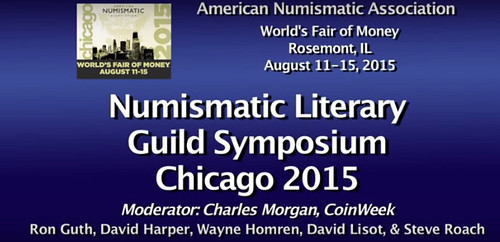
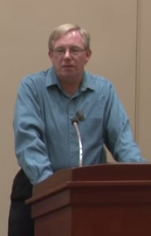 "Technology and Numismatic Journalism" was the theme of the 2015 Numismatic Literary Guild Symposium at last month's American
Numismatic Association World's Fair of Money. Videographer David Lisot has published a video of the entire proceeding on the CoinWeek
site. I enjoyed having the opportunity to participate; it was a lively and thoughtful exchange. If you weren't able to be present (or even if you
were), I recommend watching the complete video. The topics discussed cover issues of importance to every numismatic club and publisher who wishes to
remain relevant today and into the future. -Editor
"Technology and Numismatic Journalism" was the theme of the 2015 Numismatic Literary Guild Symposium at last month's American
Numismatic Association World's Fair of Money. Videographer David Lisot has published a video of the entire proceeding on the CoinWeek
site. I enjoyed having the opportunity to participate; it was a lively and thoughtful exchange. If you weren't able to be present (or even if you
were), I recommend watching the complete video. The topics discussed cover issues of importance to every numismatic club and publisher who wishes to
remain relevant today and into the future. -Editor
Moderator: Charles Morgan, with Ron Guth, David Harper, Wayne Homren, David Lisot, and Steve Roach.
The Numismatic Literary Guild held a symposium at this years ANA Convention in Chicago and brought some of the most influential people in the world of numismatic media talk about the latest trends in communication and the internet.
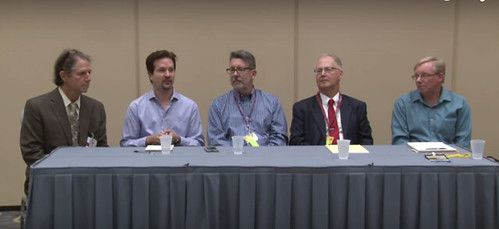
David Lisot, Steve Roach, Ron Guth, David Harper, Wayne Homren
Martin Kaplan writes:
I watched the very interesting video on the NLG Chicago Symposium posted on the CoinWeek website. ISN'T this an exciting time we are living in!
To view the complete video, see:
Numismatic Literary Guild
Symposium Chicago 2015. VIDEO: 57:37 (www.coinweek.com/education/numismatic-literary-guild-symposium-chicago-2015-video-5737/)
THE E-SYLUM, GOOGLE, AND NUMISMATICS ON THE INTERNET
Last week I noted that The E-Sylum was founded on September 4, 1998. Garrett Ziss (age 12) writes:
Happy 17th Birthday to The E-Sylum! Did you know that another helpful numismatic resource was started on the same day as The E-Sylum? Google was also founded on September, 4 1998. Of course you can google Google to get more information!
I shared this with Anne Bentley, who writes:
That's a hoot, Wayne! And you're both still going strong.
![]() Wow - I didn't know that! That's a great coincidence. At the end of 1998 I quit my software development job to become a Product
Manager for a search engine company - Lycos, Inc. Clearly, I hitched my wagon to the wrong horse. It was a great experience, though - one of the best
jobs I've ever had.
Wow - I didn't know that! That's a great coincidence. At the end of 1998 I quit my software development job to become a Product
Manager for a search engine company - Lycos, Inc. Clearly, I hitched my wagon to the wrong horse. It was a great experience, though - one of the best
jobs I've ever had.
A couple years earlier I was showing one of our company sales guys how I'd learned to use some early Internet tools to find and download software I could use for a project. Big deal, right? Well, now it's commonplace, but in 1996 it wasn't. I told him, "This is going to change the world."
That was before the World Wide Web and the Mosaic browser which suddenly made all the Internet's content much more accessible. But it was already accessible to me, as a geek who knew how to press all the right technical buttons. Opening the 'net up to the masses truly did change the world.
I taught myself HTML and built the NBS web site. Then I used what I learned at work, and built one of the world's first commercial platforms (a self-service provisioning portal for a telephone company). Then I started what we now know as The E-Sylum. Initially, it was a platform to update NBS members and friends on changes to the NBS website. But little by little it got bigger and bigger, like Clifford the Big Red Dog. And now it's huge.
The Internet is huge now, too, and has changed almost every aspect of numismatics. Where once we were basically the ONLY club e-newsletter in the country (if not the world), now nearly every organization has one. And nearly every club, museum, auction house and Mom-and-Pop coin dealer has a web site.
But have we finally arrived at the glorious end state? Is this all there is? I'm reminded of what my highly-compensated C-level management at Lycos told me when I asked for funding to purchase some hardware to build a cluster of PCs to replace the hulking million-dollar DEC Alpha supercomputers we'd been using to host the search engine:
"All the money's already been made in search."
My jaw drops even now, just as it did back then. They honestly thought that the search business had become a commodity, that it was everywhere, cheap, and there was no way to squeeze more money out of it. So they wouldn't invest.
![]() So guess what? A little company with a funny name - Google - came along and showed them just how wrong they were. Search and the Internet
in general have moved light years beyond those quaint early days.
So guess what? A little company with a funny name - Google - came along and showed them just how wrong they were. Search and the Internet
in general have moved light years beyond those quaint early days.
So as numismatists, we shouldn't get too comfortable with the status quo. Sure, numismatic Internet auctions, electronic publishing, eBay, e-newsletters, and social media are all great. But technology doesn't stand still. And it's going to change the world all over again. And when Garrett's my age, he'll look back on today as the quaint early days. Stay tuned. You ain't seen nothin' yet.
To read the earlier E-Sylum article, see:
WAYNE'S WORDS: THE E-SYLUM AUGUST 30, 2015
(www.coinbooks.org/esylum_v18n35a01.html)

VIDEO: DAVID FANNING ON THE MARGO RUSSELL LIBRARY

Charles Morgan, David Fanning
To read the complete article, see:
Kolbe &
Fanning to Auction Margo Russell Collection of Books. VIDEO: 7:52.
(www.coinweek.com/coins/supplies/books-2/kolbe-fanning-to-auction-margo-russell-collection-of-books-video-752/)
DANA BICKFORD'S PATTERN COINAGE
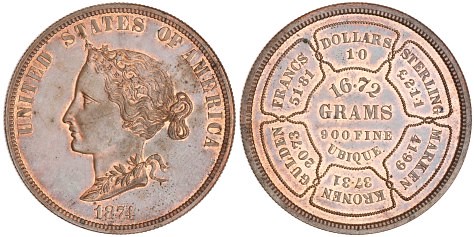
This past week I have been working on my presentation for the upcoming International Numismatic Congress, which concerns U.S. trade dollars, the ill-fated silver coin issued in the 1870s for trans-Pacific commerce.
Although the trade dollar was the only one struck for international circulation, there were some interesting patterns dating to this period of expanding global commerce, perhaps most notably the 1874 ‘Bickford’ $10 coin.
This particular $10 pattern coin was suggested by the seemingly indefatigable Dana Bickford (1834-1909), a businessman and inventor who had the ear of Henry R. Linderman, the superintendent of the United States Mint.
Dana Bickford’s most notable legacy, at least for numismatists, was the idea for a coin that he proposed to Henry Linderman for the US Mint in 1874. The genesis of the pattern was detailed in the February 1876 edition of the Coin & Stamp Journal, which reprinted an article that originally appeared in the Philadelphia Inquirer on January 31.
The summary version is that Bickford was traveling through Europe in 1873 and experienced all the “difficulties and inconveniences” that accompanied exchanging for and understanding the “money current” in each of the countries that he visited. (That part of the story checks out as Bickford lodged an application with the Department of State for a passport in February 1873). The idea he hit upon while traveling was for a coin that would have its exact composition on its face, as well as its value in terms of each of the major commercial currencies. Bickford called at the mint in Philadelphia when he returned, and Linderman thought enough of the idea that dies were prepared and a pattern was struck. The ANS holds a copper specimen (Judd-1374), but it was also struck in aluminum, nickel, and gold.
Bickford’s proposed system of international coinage would allow countries to display their own particular design on the obverse (hence the Liberty Head), but required that the fineness, weight, and exchange value of the coin be expressed on the reverse. Although struck in copper, this was supposed to be a $10 gold coin or Eagle with a weight of 16.72 grams. The indication that it was .900 fine meant that it contained 15.046 grams or .48375 troy ounces of pure gold. Six cartouches circle the reverse with the value of the coin in US dollars ($10), British pounds (£2.1.1), German marks (41.99), Danish kroner (37.31), Dutch gulden (20.73), and French francs (51.81). The UBIQUE inscription stands for ‘ubiquitous,’ implying that the coin was good everywhere.
Although this was likely an impossible scheme to implement in practical terms, the coin was an intriguing idea in theory. Beginning with the formation of the Latin Monetary Union in 1865, there were a series of international monetary conferences and related efforts to create a more uniform and stable global currency system. The big problem for Bickford’s proposed coinage was that although the price of gold was relatively steady, not all nations were on a gold standard. A drop in the price of silver during the 1870s destabilized the currencies of those countries on a silver or bimetallic standard by dramatically shifting the gold price of silver. This in turn led to fluctuations in exchange rates that would have been impossible to keep up with in terms of minting and circulating coins.
 Despite the fact that Bickford’s patterns were never put into production, he could not seem to let the idea go. In 1897, he issued a series
of bimetallic “Republican International Dollars” in the same vein as the earlier pattern coins, with exchange rates for the Russian rouble and
Japanese Yen helpfully added. Although this particular specimen was a model made with brass and aluminum, the intention was that the actual dollars
would contain gold and silver.
Despite the fact that Bickford’s patterns were never put into production, he could not seem to let the idea go. In 1897, he issued a series
of bimetallic “Republican International Dollars” in the same vein as the earlier pattern coins, with exchange rates for the Russian rouble and
Japanese Yen helpfully added. Although this particular specimen was a model made with brass and aluminum, the intention was that the actual dollars
would contain gold and silver.
Bickford rather optimistically expressed the hope, which is inscribed on the obverse, that “This Combination Coin Will When Adopted be Good in All Nations / Heal All Differences Between Gold & Silver Men / and Fully Settle All Financial Questions.”
To read the complete article, see:
Bickford’s International Pattern Coin, 1874
(www.anspocketchange.org/bickfords-international-pattern-coin-1874/)
MORE ON THE SOUTH CAROLINA OBSOLETE BANKNOTE HOARD
Ron writes:
The South Carolina Civil War Era $5 notes probably came from a hoard auctioned by The South Carolina Department of Archives and History in April 2008. There were approximately 800 uncut sheets and 11,000 single notes. I believe that most, if not all, of these bulk lots were bought by the prominent South Carolina dealer in Civil War currency. There were numerous subsequent auctions (some on eBay) of lesser material
South Carolina Department of Archives and History is offering for sale through a sealed bid auction State of South Carolina currency that was redeemed and cancelled by the state in the nineteenth century.
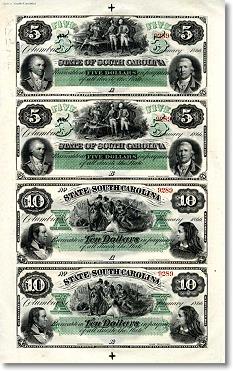 The notes available are State of South Carolina January 1, 1866 uncut sheets of $1, $2, $5 and $10 (Sheheen 1, 2, 3, 4).
The notes available are State of South Carolina January 1, 1866 uncut sheets of $1, $2, $5 and $10 (Sheheen 1, 2, 3, 4).
There are 623 uncut sheets of $1 and $2 signed by the comptroller general; 60 uncut sheets of $1 and $2 signed by both the comptroller and treasurer; and 150 uncut sheets of $5 and $10 with no signatures. 1866 Uncut sheets Unsigned The These will be sold in 10 (lots 1-10) equally divided lots each containing 80 uncut sheets. Each lot contains 6 $1 and $2 sheets signed by the comptroller general and the treasurer; 60 $1 and $2 uncut sheets signed by the comptroller general; and 14 $5 and $10 unsigned sheets.
One additional lot (lot 11) contains 23 $1 and $2 sheets signed by the comptroller general and 10 $5 and $10 unsigned sheets. All sheets are average-vf or better. All of these sheets are cut cancelled. The minimum bid is $3,200 for lots 1-10 and $1,300 for lot 11.
Also available are State of South Carolina December 1, 1873 in denominations of $1, $2, $5, $10, $20, and $50 (Sheheen 16-21). There are a total of 11,037 notes, 6,164 are ink cancelled and 4,873 are cut cancelled.
All notes are average-vf or better. These will be sold in 6 equal lots (lots 12-17) each containing 945 ink cancelled notes and 730 cut cancelled notes. There is also an 18th lot containing 494 ink cancelled and 493 cut cancelled notes. The minimum bid is $15,000 for lots 12-17 and $9,500 for lot 18.
To read the complete article, see:
19th Century South Carolina Currency Sale
(www.coinlink.com/News/banknotes/19th-century-south-carolina-currency-sale/)
State officials have quietly picked through boxes of Civil War state currency and auctioned it on eBay, providing the state archives with an influx of cash amid tight budgets.
“These are very bad times,” said Charles Lesser, a senior archivist at the South Carolina Department of Archives and History. “This helps us a great deal. We can pay for things we could never afford otherwise.”
About 40 boxes of the currency were supposed to be destroyed more than a century ago, but some of the bills were tucked away in the Statehouse basement and eventually moved to the state archives. They sat there largely undisturbed for four decades, and only recently did officials realize they could sell the cash.
The archives have made about $200,000 selling hundreds of the bills over the past couple of years. Most of that money was made in an auction of uncut sheets of the currency last year, but every week or so, South Carolina puts a couple of loose bills up for sale online. The old money is a little wider, whiter and lighter than today’s paper money.
Last month, a bill from the Bank of South Carolina worth $4 when it was issued almost 150 years ago fetched nearly $400.
The man behind the project is Jack Meyer, 74, a retired University of South Carolina history professor who volunteers about eight hours a month to sift through the boxes and find bills in good enough condition to sell. In a year and a half he has made it through one of the 40 boxes.
“I’ve got job security,” Mr. Meyer said.
When the South lost the Civil War, Confederate money became worthless and the new Reconstruction government in South Carolina refused to cover the paper money issued by the state when it was not a part of the United States.
Several other Southern states went through a similar process after the Civil War, but Rodger Stroup, director of the state archives, said that as far as he knew, only South Carolina had failed to destroy all of its currency, bringing this unexpected windfall more than a century later.
Mr. Meyer spends every other Tuesday at a simple table in a third-floor room of the archives armed with a magnifying glass and bundles of bills. He tries to find bills that are not wrinkled or torn or look particularly aged. It is tedious work that reminds the occasionally acerbic academic of the decades he spent in the Air Force.
“It’s very interesting,” he said. “It’s like the military — 90 percent boredom, 10 percent excitement.”
The excitement comes at the least expected times, like the day Mr. Meyer said he turned over a $1 note and found a handwritten message: “The last of fifty-thousand and this is going for whiskey.”
That bill was preserved and will stay in the state archives, along with the best samples of every other distinct kind of currency Mr. Meyer finds as he goes through the boxes.
For each sale, the South Carolina archives pays a small fee to eBay and to the state surplus agency that handles the transaction. State law prevents the proceeds from going toward salaries, but allows the purchase of supplies like acid-free storage boxes and projects like digitizing frequently viewed documents, said Mr. Stroup, the archives director.
To read the complete article, see:
South Carolina Is Seeing How Far Some Civil War Cash Can Go
(www.nytimes.com/2009/06/07/us/07cash.html) http://www.coinlink.com/News/banknotes/19th-century-south-carolina-currency-sale/ .
To read the earlier E-Sylum article, see:
QUERY: SOUTH CAROLINA OBSOLETE BANKNOTE HOARD
(www.coinbooks.org/esylum_v18n35a22.html)

NEW £20 COIN HOLDS FIVE PORTRAITS OF ELIZABETH II
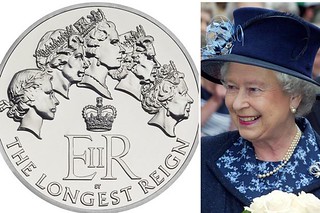 A commemorative coin depicting the Queen through her reign has been unveiled to mark her becoming the longest reigning monarch in British
history.
A commemorative coin depicting the Queen through her reign has been unveiled to mark her becoming the longest reigning monarch in British
history.
The Royal Mint has designed the £20 fine silver face value coin depicting the Queen’s journey through the five portraits that have appeared of her on UK coins.
Designed by Stephen Taylor, it shows the Queen all the way from her coronation to now.
Mr Taylor said: “I wanted my design to convey how Queen Elizabeth II has matured on the face of a coin, just like Queen Victoria did.
“Combining the five portraits was a challenge, as they are all quite different in their composition: how they’re couped, their size, the crown worn and so on. The font I used for the inscription is a flared serif often used on early coinage. Mary Gillick used something similar on her portrait of Her Majesty. “
The Royal Mint, in Llantrisant, said that never before had all coins in circulation carried the portrait of the same monarch.
Shane Bissett, The Royal Mint’s director of Commemorative Coin and Medals, said: “This historic event is not only a memorable one for the nation, but a significant one for The Royal Mint, maker of coins to the kings and queens of Britain for over 1,000 years.
To read the complete article, see:
The Royal Mint unveils a £20 silver coin
tracing the Queen's reign through five portraits (www.walesonline.co.uk/news/wales-news/royal-mint-unveils-20-silver-9962719)
ARCHIVES INTERNATIONAL SALE XXVIII HIGHLIGHTS
Lot 25: Bank of China, 1917 "Kalgan" Branch Issue Rarity
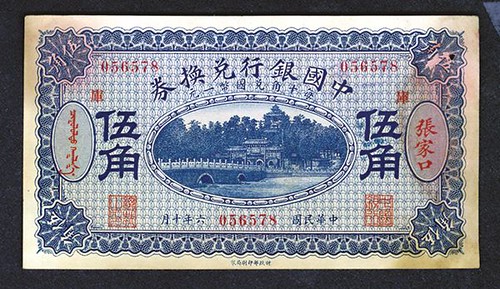
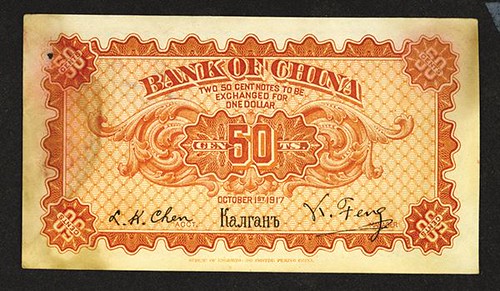
Kalgan (Cyrillic text), 50 cents, P-45c S/M#C294-74c, Issued banknote, Blue face with red text, bridge with building, back orange, toning on the lower right and left borders otherwise Uncirculated. BEPP. Rarely seen branch issue and first time seen by cataloger. Extremely rare note in any condition and possibly one of the finest known in this condition. The note catalogs $5500 in XF in the SCWPM. This one of two examples offered in this auction of this type and is sure to attract spirited bidding. (Ex-Pogrebetsky Family Archives)
To read the complete lot description, see:
http://auction.archivesinternational.com/Bank-of-China-1917-Kalgan-Branch-Issue-Rarity_i23251732
Lot 220: Banco Nacional Del Paraguay, 1886 Issue Proof.

Asuncion, Paraguay, January 1, 1886, 100 Pesos Fuertes, P-S151P, Face and back proofs, printed in black on orange and blue underprint on india on thin large margined card on three sides and cut down to banknote size for the back, the back is blue, Standing Liberty and eagle at left, Paraguay arms in middle and Gen. Caballero at right, Choice to Gem Uncirculated condition with the close margin on bottom keeping this amazing note from Gem Unc., extremely rare note in any form. Rarely seen at auction. ABNC.
To read the complete lot description, see:
http://auction.archivesinternational.com/Banco-Nacional-Del-Paraguay-1886-Issue-Proof_i23251927
Lot 567: Wisconsin Soldiers; Home Contribution Stock Certificate, ca. 1865
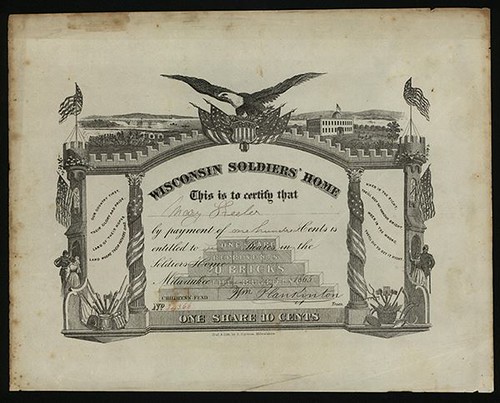
Milwaukee, WI. 10 Shares. Issued and uncancelled. Ornate design of patriotic eagle with shield and flags with city and lake scene behind it held up by columns with American flags with soldiers and the middle has a light grey undertint of bricks "One Share Represents 20 Bricks". William Plankinton facsimile signature as treasurer. Overall, it appears Fine to VF condition. Rare and historic Civil War related certificate.
To read the complete lot description, see:
http://auction.archivesinternational.com/Wisconsin-Soldiers-Home-Contribution-Stock-Certificate-ca-1865_i23252274
Lot 762: Central Railroad Co. of New Jersey, ca.1900 Specimen Stock Certificate
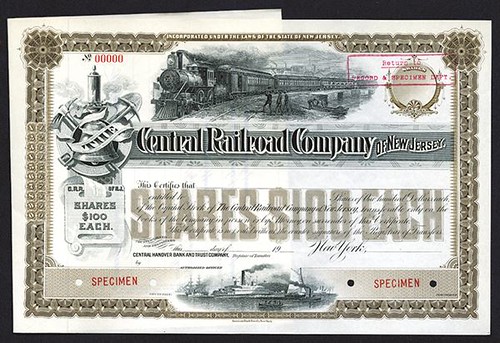
New Jersey, 19xx (ca. 1900-1910), Odd shs., Specimen, Black with brown border and underprint, Locomotive #35 around curve with men waving R-L on top and ferry in harbor scene on bottom, left with ornate design, POC's, XF, ABNC. Specimen only, not known issued in Cox.
To read the complete lot description, see:
http://auction.archivesinternational.com/Central-Railroad-Co-of-New-Jersey-ca-1900-Specimen-Stock-Certificate_i23252469
Lot 992: Plate Printer's Union Coated Stock Invitation Pair ca. 1870's
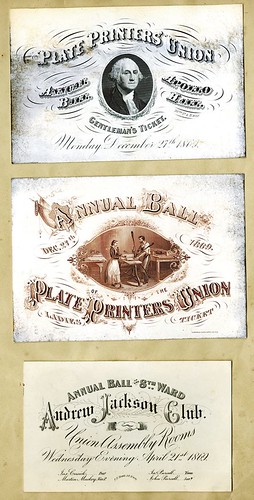

Tickets for the Plate Printer's Union Ball of 1869 (Gentleman's and Ladies Ticket); Andrew Jackson Club, 1869; Society of the Army & Navy of the Gulf, 1870, Civil War Related; Rutgers Female College Commencement, 1870; Dickinson Ball, 1850; First Troop Washington Greys; Invitation calligraphy on monogram stationary, 1871. Mounted on three pages of fragmenting scrapbook pages not effecting cards. 8 pieces
To read the complete lot description, see:
http://auction.archivesinternational.com/Plate-Printer-s-Union-Coated-Stock-Invitation-Pair-ca-1870-s-and-Andrew-Jackson-Club-Invitation_i23252699
Lot 1065: Gold $1 Coin Vignettes used on Obsolete Banknotes
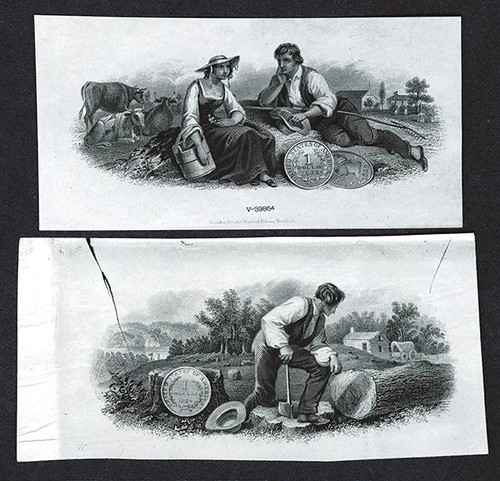
ND (ca.1852-53). Lot of 2 different proof vignettes. Both have gold $1 coins dated 1852. One has agricultural related vignette of man and woman with cows and farm with imprint of RWH&E, the second vignette has a resting wood chopper with hat on ground next to coin with no imprint, but probably a RWH&E engraving. Both are printed on india paper and are not mounted. Both are in XF condition.
To read the complete lot description, see:
http://auction.archivesinternational.com/Gold-1-Coin-Vignettes-used-on-Obsolete-Banknotes_i23252772
ARCHIVES INTERNATIONAL AUCTIONS, LLC
1580 Lemoine Avenue, Suite #7
Fort Lee, NJ 07024
Phone: 201-944-4800
Email: info@archivesinternational.com
WWW.ARCHIVESINTERNATIONAL.COM
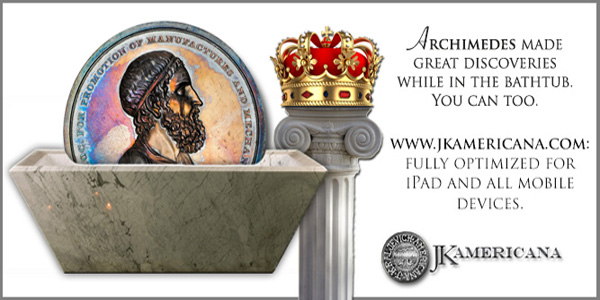
A GOLD SIGISMUND III PORTUGALÖSER OF POLAND

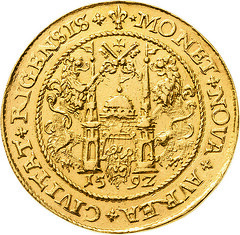
Sigismund III – King of Poland, King of Sweden
The early modern era was much more democratic that we are inclined to believe. The Polish chose a Swedish king, and the Swedes forced that Polish king to make great concessions, when he started to control their country as well. A unique coin bears testimony to these events.
On June 20, 1566, a baby was born in a prison cell at Gripsholm Castle. The name of the father was John Vasa. He was the younger brother of the Swedish king, and was to dethrone him only a few years later. The mother of the child was called Catherine, and she was the youngest daughter of Sigismund I, King of Poland.
Thus, it was a real political statement when the small child was baptized Sigismund, a very unusual name in Sweden, and was given a Catholic education in that Protestant country.
One has to bear in mind that Poland was an elective monarchy. The parliament not only exerted great influence on legislation but actually elected the ruler of Poland and Lithuania. At the time of his election, in 1587, Sigismund was no more than 21 years old. Within less than five years, in 1592, as the date when our coin was minted, his father, John III, King of Sweden, was dead and the young man would have loved to assume the second kingdom.
To do so, Sigismund needed to have the Polish parliament’s permission that he was entitled to announce his candidature in Sweden. This is where the gorgeous portugalöser comes in, which will be on sale at Auction 84 of Leipziger Münzhandlung und Auktion Heidrun Höhn e. K., on October 24, 2015. The specimen has a pre-sale estimate of 30,000,- euros.
Back in the 16th century, it was something of a royal custom to promote the loyalty of one’s subjects by presenting them with lavish gifts. High-ranking persons were given presentation pieces (‘schaustücke’ in German), such as this magnificent high-denomination gold coin. It was not the same as modern-day bribery, but rather a confirmation of the good relations by means of a generous gift.
The obverse of the coin depicts Sigismund III as Polish King. He holds the clearly discernible Polish scepter and wears the crown of the Polish kings. The legend translates as: ‘Sigismund III, by the Grace of God King of Poland, Grand Duke of Lithuania’. The coin’s reverse refers to the city of Riga which belonged to the Polish-Lithuanian Commonwealth in those days. ‘The New Gold Coin of the City of Riga’ translates the inscription on the reverse. As another element of the depiction, we see the coat of arms of Riga: a city gate, held by two lions, with two crossed keys and a cross above. The lesser coat of arms, which divides the date 1592, shows the white knight, indicating that Riga did not mint in its own right but by royal order as part of the Grand Duchy of Lithuania.
Poland often issued high-denomination gold coins, such as this one. They were called portugalöser, hinting at the coins they were modelled on. These coins came from Portugal and were popular throughout Europe. They differed from local everyday change in that their intrinsic value roughly corresponded to their nominal value. Because of that, they could circulate everywhere. Furthermore, their value remained constant even in times of demonetarization, which made them suitable for saving. Though the coin illustrated here is extremely rare today, it seems safe to assume that a considerable number of specimens were struck in 1592. An 1839 publication giving a description of a small variant of our die serves as proof that it actually took two reverse dies in 1592 in order to produce the emission. Most specimens are likely to have been melted down at some point, because of their metal value. The authors, writing at 1839, appraised the specimen at 300 zloty. That made the coin the then most expensive coin in the Cracow Museum. It remains to be seen what the coin is going to obtain today.
Not to forget, Sigismund III actually succeeded in becoming King of Sweden. He could only do so after having allowed the Swedes to make Protestantism the official religion of the empire.
The specimen will cross the auction block in the Hotel Raddisson Blu in Leipzig on October 24, 2015. Auction sale 84 is devoted to German coins as well as world coins. On the preceding day, an outstanding batch of paper money will be offered for sale. Both auction sale catalogs may be ordered at Leipziger Münzhandlung und Auktion Heidrun Höhn e.K., Nikolaistraße 25, 04109 Leipzig. Phone 0341-12 47 90, telefax: 0341-211 72 45, e-mail: info@leipziger-muenzhandlung.de, homepage: http://www.leipziger-muenzhandlung.de/Homepage_en.AxCMS .
GORNY & MOSCH AUCTIONS 232-234
October 5-9, 2015
Gorny & Mosch
Auction 232-234
Over the course of its auction week, Gorny & Mosch will conduct three auction sales. The event on Monday will focus on high-quality ancient coins. On Tuesday and Wednesday, the “ordinary” ancient coins will come up for bid in Auction 233. In the auction to be held on Thursday, rarities from Medieval and Modern Times will be offered for sale. And the entire Friday will be devoted to Islamic coins as well as Russian coins, medals and decorations.
Lot 70: SYRACUSE (Sicily). Tetradrachm, ca. 415-405. Very rare. Very fine. Estimate: 26,000,- euros
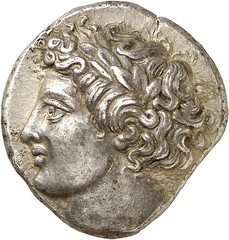
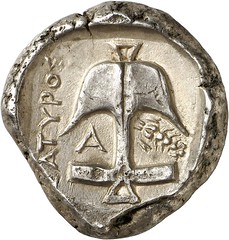
Lot 96: APOLLONIA PONTICA (Thrace). Tetradrachm, ca. 400-350. Rare. Extremely fine. Estimate: 12,000,- euros
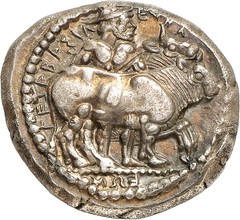
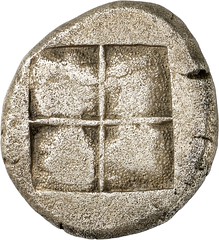
Lot 119: EDONES (Thraco-Macedonian Tribes). Octodrachm, ca. 479-465. Very rare. Extremely fine. Estimate: 80,000,- euros
Lot 178: ATHENS (Attica). Wappenmünzen. Didrachm, 545-525/515. Very rare. Extremely fine. Estimate: 15,000,- euros
Lot 182: ATHENS (Attica). Wappenmünzen. Didrachm, 545-525/515. Extremely rare. Extremely fine. Estimate: 15,000,- euros
Lot 187: ATHENS (Attica). Tetradrachm, about 505-490. Very rare. Extremely fine. Estimate: 5,000,- euros
Lot 243: PHAISTOS (Crete). Stater, about 322-300. Nearly extremely fine. Estimate: 1.200,- euros
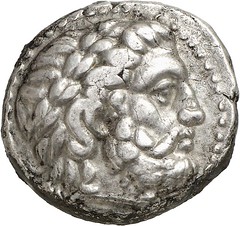
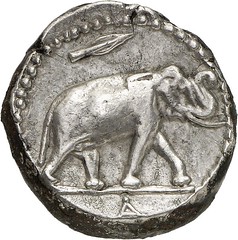
Lot 293: SELEUCUS I (312-281). Tetradrachm, 288-287, Susa. Very rare. Nearly extremely fine. Estimate: 20,000,- euros
Lot 351: ROMAN REPUBLIC. Anonymous. 40 asses, 211-207, Rome. Extremely rare. Extremely fine. Estimate: 25,000,- euros
Lot 407: BRITANNICUS, 41-55. Sestertius, Thrace. Rare. Very fine. Estimate: 4,500,- euros


Lot 423: DOMITIAN as Caesar, 69-81. Aureus, 73, Rome. Extremely fine. Estimate: 20,000,- euros

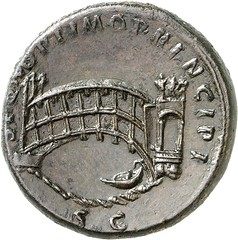
Lot 430: TRAJAN, 98-117. Sestertius, 112-113, Rome. Rare. Extremely fine. Estimate: 6,000,- euros
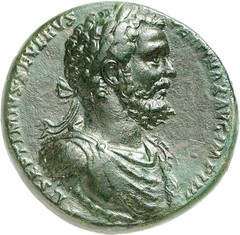
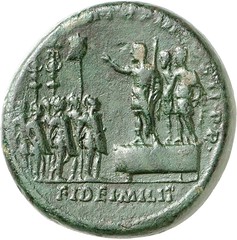
Lot 456: SEPTIMIUS SEVERUS, 193-211. AE-medallion, 195. Very rare. Extremely fine. Estimate: 35,000,- euros
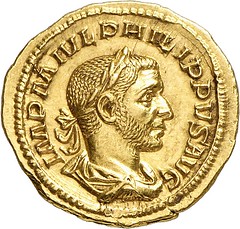
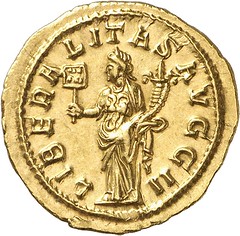
Lot 467: PHILIPPUS I ARABS, 244-249. Aureus, 244-247, Rome. FDC. Estimate: 32,000,- euros
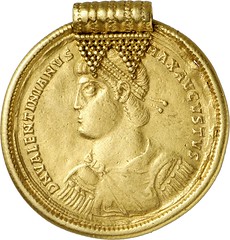
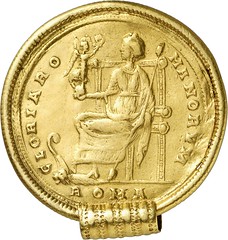
Lot 524: VALENTINIANUS, 364-375. Multiple of 9 solidi, Rome. Unique. Unpublished. Very fine. Estimate: 75,000,- euros
The multiple to be auctioned off equals 9 solidi. It was given as a donative to distinguished dignitaries and officers. The mounting with a granule decoration and a hole suggests that the gorgeous medal was worn on a chain – for a longer period of time, as indicated by the traces of wearing. The identity of its wearer cannot be ascertained anymore. Surely, the medal was given to a barbarian ruler as one of Rome’s allies. Giving away a medallion, graced by the portrait of the emperor, was a Roman way of nobilitating the presentee, to the effect that his rule was almost divinely legitimized. Apart from that, both the influence and the charisma of the emperor were transferred upon the barbarian ruler. Unsurprisingly, the barbarians used to wear these gold medallions in such a way that everybody could clearly see the portrait of the emperor.
Lot 605: ARTAVASDUS, 742-743. Miliaresion, Constantinople. Rare. Very fine to extremely fine. Estimate: 3,000,- euros
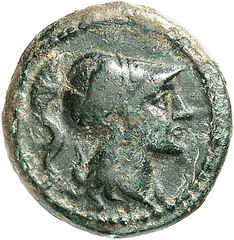
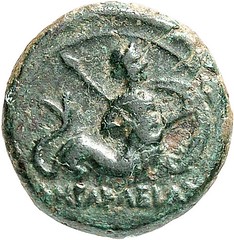
Lot 1085: HERACLEA (Lucania). AE, 380-281. Very fine. Estimate: 120,- euros
Lot 4015: AUGSBURG. 1694 thaler. FDC. Estimate: 800,- euros
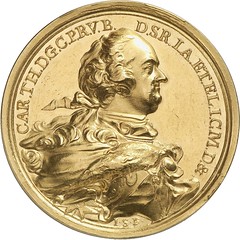

Lot 4028: BAVARIA. Charles Theodore, 1777-1799. 1777 gold medal by Joseph Scheufel on Charles Theodore taking office in Bavaria. Ex MMAG Auction, Basel (1983). Extremely rare. Extremely fine to FDC. Estimate: 25,000,- euros
Lot 4094: CORVEY. Arnold of Waldois, 1638-1661. 1652 thaler, Höxter. Only 214 specimens struck. Ex MMAG, Basel Auction 48 (1973), 352. Extremely fine. Estimate: 10,000,- euros
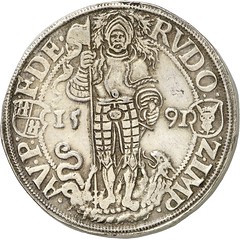
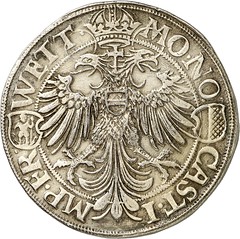
Lot 4115: FRIEDBERG. 1591 double thaler. Unique. Extremely fine. Estimate: 40,000,- euros
Lot 4153: MAGDEBURG. 1673 broad double thaler. Ex Giessener Münzhandlung Auction 6 (1973), 580. 2nd specimen known to exist. Very fine to extremely fine. Estimate: 30,000,- euros

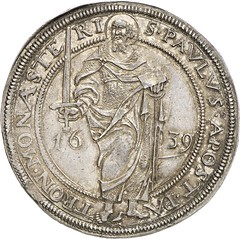
Lot 4163: MÜNSTER. Ferdinand I of Bavaria, 1612-1650. 1638 5 ducats, Münster. Ex Giessener Münzhandlung Auction 8 (1975), 524. Extremely rare. Extremely fine. Estimate: 30,000,- euros
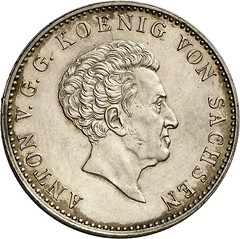
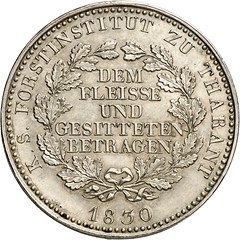
Lot 4224: SAXONY. Anthony, 1827-1836. 1830 thaler. Only 25 specimens struck. Extremely fine to FDC. Estimate: 20,000,- euros
Lot 4267: WUERTTEMBERG. William Louis, 1674-1677. 1677 thaler, Stuttgart. Very rare. Extremely fine to FDC. Estimate: 20,000,- euros
Lot 4415: SAXE-COBURG-GOTHA. Ernest II, 1844-1893. 1677 20 mark E. Extremely rare. Nearly extremely fine / extremely fine. Estimate: 65,000,- euros

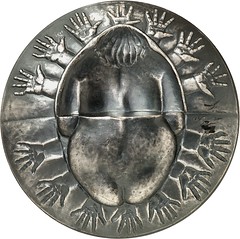
Lot 4484: KAUKO RÄSÄNEN. 1973 2-component commemorative medal on the Conference on Security and Cooperation in Europe, Helsinki. Only 50 pieces struck. Artist’s specimen! Mint state. Estimate: 500,- euros
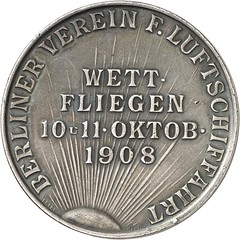
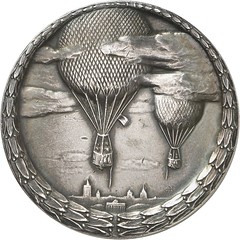
Lot 4538: AERONAUTICS. 1908 medal on the air race conducted in October that year. Very rare. Good extremely fine. Estimate: 250,- euros
Lot 4732A: GREAT BRITAIN. Alfred the Great, 871-899. “Ceolwulf type” penny. Extremely rare. Very fine. Estimate: 5,000,- euros
Lot 4733: GREAT BRITAIN. Oliver Cromwell. 1658 halfcrown, London. Very rare. Extremely fine to FDC. Estimate: 5,000,- euros
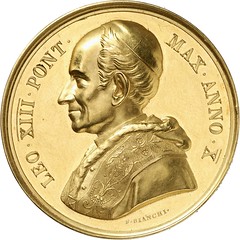

Lot 4809: VATICAN. Leo XIII, 1878-1903. 1885 gold medal by F. Bianchi on resolving the controversy about the Carolines. Very rare. Nearly FDC. Estimate: 3,000,- euros
Lot 5049: UMAYYADS. Reign of Abd al-Malik, 685-705. Dirham 80 H. Extremely rare. Very fine. Estimate: 700,- euros
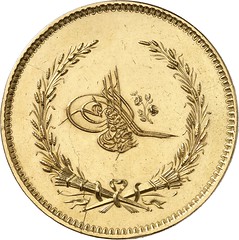
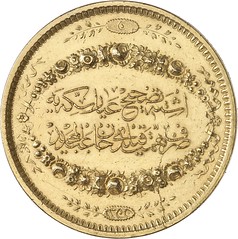
Lot 5153: OTTOMANS. Abd al-Majid, 1839-1861. On the monetary reform and the adoption of a new monetary system. Unique in this weight. Extremely fine to FDC. Estimate: 30,000,- euros
Lot 6124: RUSSIA. Paul I, 1796-1801. 1796 rouble, St. Petersburg. Coinage in the standard of an albertusthaler. Rare. Extremely fine to FDC. Estimate: 12,000,- euros
Lot 6289: RUSSIA. Order of St. Anne. 3rd class Cross, 1st model (since 1815). Very rare. Good extremely fine. Estimate: 50,000,- euros
Lot 6301: RUSSIA. Alexander III. Gold medal “For Bravery”. Specimen from the Michailovich Collection. Extremely rare. Nearly FDC. Estimate: 50,000,- euros
To view the complete catalogs, see:
https://auctionen.gmcoinart.de/

ARTIST WESLEY KLASSEN SUBMITS DESIGNS FOR CANADIAN COINS
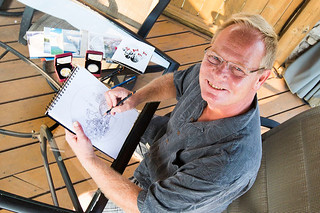 As a new coin collector, Wesley Klassen enjoys keeping an eye out different types and trying to find them in his pocket change.
As a new coin collector, Wesley Klassen enjoys keeping an eye out different types and trying to find them in his pocket change.
The idea that one of those Royal Canadian Mint coins may bear a design of his own in the future is amazing.
“To get this far, I feel like a winner already,” said Klassen, who was announced as a finalist Tuesday in the Royal Canadian Mint’s My Canada, My Inspiration coin design contest.
The 49-year-old St. Catharines man’s design featuring iconic images from across the country is one of 25 chosen from over 10,000 entries.
He found out in early August he was a finalist but had to keep it secret until Tuesday’s announcement.
“I have not been able to share this until today and it has been agonizing keeping it to myself, but for good reason,” he laughed.
“Today, it’s been an emotional roller coaster with it going public on the internet. It’s just amazing.”
Klassen, an electrician with Ontario Power Generation, has no formal art training but enjoys painting, sketching and photography as a hobby. He credits his parents with instilling the gift of creativity in their children — his father, John Klassen, designed the Town of Niagara-on-the-Lake crest in 1971 with no formal training either.
About a year ago, Klassen said a friend got him interested in coin collecting and he learned about the mint’s contest from an email.
The idea for his coin featuring Canada’s achievements started with Sir John A. MacDonald’s 200th birthday anniversary this year and his promise to connect Canada from coast to coast by railroad. Klassen based the sketch around the train idea but wanted to tie it together so it represented as much of Canada as possible. Starting from east to west, he added fishing boats, a lighthouse and Peggy’s Cove, Chateau Frontenac, the CN Tower, Prairie grain elevators and Lions’ Gate Bridge in B.C.
To read the complete article, see:
St. Catharines man’s design right on
the money (www.stcatharinesstandard.ca/2015/09/01/st-catharines-mans-design-right-on-the-money)
ARTIST TURNS ENGLISH BANKNOTES INTO SCOTTISH MONEY
 Edinburgh-based artist Trevor Jones lampoons the uncomfortable ordeal of using Scottish banknotes in England in a new exhibition of art and
technology
Edinburgh-based artist Trevor Jones lampoons the uncomfortable ordeal of using Scottish banknotes in England in a new exhibition of art and
technology
Handing over a Scottish banknote to a cashier south of the Border can be a fraught experience.
Your perfectly legitimate note is squinted at, thrust into the air, scored with a pen, and scanned with a laser – and it might still be refused anyway.
Artist Trevor Jones has turned this anxiety-inducing exchange on its head in a new exhibition at Edinburgh’s Dundas Street Gallery, which brings together painting and technology in ways that either enhance or alter the gallery space.
Jones will only accept Scottish banknotes for visitors looking to purchase his artworks – but, with an augmented reality app, he can transform Bank of England notes into Scottish currency (Flower of Scotland will play from the iPad when this happens – a cheeky flourish).
Running from Wednesday until September 9, #EdinburghHacked promises to connect painting with augmented reality technology to create artworks that are transformed by the collision of tradition and innovation.
To read the complete article, see:
Artist turns
English banknotes into Scottish money
(www.scotsman.com/lifestyle/arts/visual-arts/artist-turns-english-banknotes-into-scottish-money-1-3873609)

NEW ZEALAND BANKNOTE TO FEATURE SIR EDMUND HILLARY
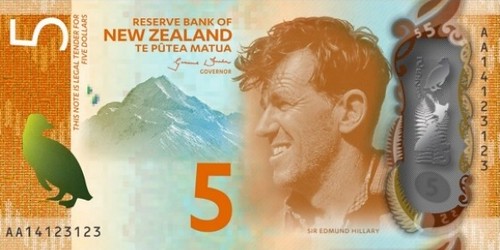
Sir Edmund Hillary's daughter has given the clearer picture of her father on the new $5 note a big thumbs up.
Sarah Hillary described the new banknotes, unveiled on Tuesday by the Reserve Bank, as "beautiful".
The new $5 note features a more photo-realistic picture of Sir Ed that Sarah Hillary described as "an improvement" over the current note.
She applauded the notes' design and their clarity and colourfulness.
The Reserve Bank said new "brighter" $5 and $10 notes would enter circulation within weeks.
The remaining $20, $50, and $100 banknotes in the new series will be released from April 2016.
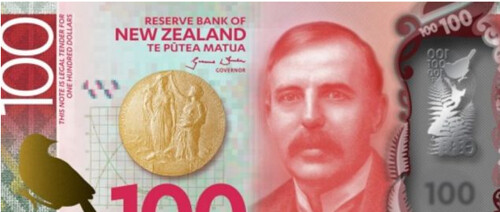
To read the complete article, see:
Sir Edmund
Hillary's daughter applauds 'beautiful' new NZ banknotes
(www.stuff.co.nz/business/money/71624634/sir-edmund-hillarys-daughter-applauds-beautiful-new-nz-banknotes)
BRITAIN'S £20 POLYMER BANKNOTE ANNOUNCED
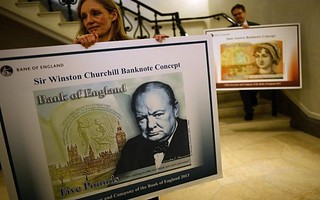 Britain's next £20 note will be printed on plastic in a move designed to make the UK's currency more secure and durable.
Britain's next £20 note will be printed on plastic in a move designed to make the UK's currency more secure and durable.
The new £20 design will be the third banknote to be printed on polymer, the Bank of England announced on Wednesday, following a 10-week public consultation that showed 87pc of respondents were in favour of the change.
The new note is expected to enter circulation by the end of the decade. The Bank announced in December 2013 that the next £5 and £10 banknotes would be printed on polymer.
The new polymer £5 note featuring former prime minister Sir Winston Churchill will be issued in autumn 2016. Victoria Cleland, the Bank's chief cashier, said that De La Rue, which is in charge of the contract, will start printing the new notes this month.
The £10 polymer note featuring author Jane Austen is expected to enter circulation in 2017.
The £20 note is Britain's most common tender, with around 1.9 billion in circulation at the end of February, compared with 737 million £10 notes, according to Bank data. Ms Cleland said the switch to plastic would help to reduce fraud and ensure banknotes were more durable.
"Experience from central banks that have issued polymer banknotes has been positive. Canada, for example, has seen a real reduction in counterfeit levels since launching its polymer series a few years ago. Polymer is also cleaner and more durable, leading to better quality notes in circulation," she said in a speech in Bristol.
To read the complete article, see:
Britain's most
common banknote goes plastic
(www.telegraph.co.uk/finance/bank-of-england/11838825/Britain-banknote-20-plastic-polymer-bank-of-england.html)

CANADIANS CUT $20S IN HALF AND SPEND THEM
Did they run out of change? Nobody's quite sure how it began, but people in a Canadian region have been cutting their money in half before they spend it, the CBC reports. In Quebec's Gaspe region—an area the size of South Carolina, with around 140,000 residents—some retailers accept the halved $20s, $10s, and $5s at half the original value. Residents are calling the "new" local currency the "demi," which is French for "half."
The Bank of Canada says that while the practice isn't outlawed, it is "inappropriate" to cut your money in half. Gaspe residents argue that use of the demi, which apparently began earlier this year, boosts the local economy by making sure cash stays in the area. "In the worst case, if we find ourselves in trouble, we just need to make a call out to collect all the bills with the same serial number to restore the value," a demi user tells the CBC. "We can always put them back together." (Canada stopped making pennies a couple of years ago.)
To read the complete article, see:
Canadians Are Cutting $20s in Half,
Spending Them (www.newser.com/story/212166/canadians-are-cutting-20s-in-half-spending-them.html)
To read the earlier E-Sylum article, see:
CANADIANS ASKED TO QUIT "SPOCKING" BANKNOTES
(www.coinbooks.org/esylum_v18n10a29.html)
COLONEL BERNARD BERNSTEIN, RESTORER OF NAZI PLUNDER
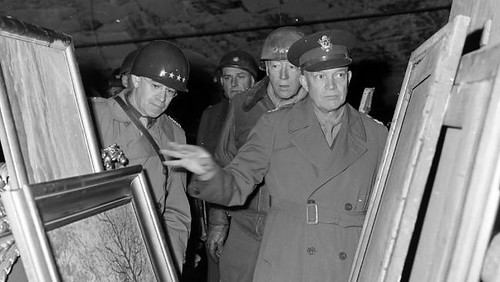
The three American generals — Dwight Eisenhower, Omar Bradley and George S. Patton — gazed in awe at the Nazi gold, more than 8000 gold bars and 2400 bags of gold coins, the largest hoard of stolen plunder ever assembled.
“If these were the old freebooting days when a soldier kept his loot,” Bradley whispered to Patton, “you’d be the richest man in the world.”
The date was April 10, 1945. Four days earlier, American troops had discovered the hoard in the Merkers mine northeast of Frankfurt: the entire reserves of the Berlin Reichsbank, gold, cash and treasure systematically stolen by the Nazi regime, and hidden underground 300km from Berlin to protect it from Allied bombing. The generals pondered what to do with it.
Patton had a typically blunt idea: the gold should be cut up into medals, he said, and handed out to his troops, “one for every son-of-a-bitch in the Third Army”. But the Americans did not keep what they had found. Instead, it was itemised, packed up, guarded, and returned to survivors of the Holocaust, the families of victims and the people from whom it had been stolen, in one of the most remarkable and little-known operations of the war, carried out by an army bean-counter most people have never heard of.
Nazi gold is back in the news after the discovery of a possible train buried in a Polish tunnel that may or may not be filled with treasure, if it exists. Certainly, stolen plunder went missing in the chaotic tail-end of the war — some of it, like the Amber Room, priceless. But thanks to a combination of precise German bookkeeping, Allied scruples and bureaucratic efficiency, the vast majority was found and restored to its rightful owners.
The real story of Nazi gold is not how much was lost, but how much was saved. The Merkers mine hoard presented the US Army with a treasure trove of unprecedented proportions, and a major logistical headache. In addition to the 250 tonnes of gold, there were bales of foreign currency taken from the central banks of occupied countries, 2.7 billion in paper Reichsmarks, 400 tonnes of artworks and, grotesquely, piles of suitcases filed with gold and silver fillings, wedding rings and jewellery, the appalling pillage from the gas chambers.
In Nazi hands, the loot could finance the war indefinitely. Merkers is in Thuringia, in what would soon be the Soviet zone, and the Americans were determined to prevent Stalin from getting hold of it. The treasure had to be made safe, and fast. The man tasked with cataloguing, guarding, shifting and preserving the treasure was an officer in the financial branch at Eisenhower’s headquarters: Colonel Bernard Bernstein, a New York lawyer and economist who had spent most of the war calculating currency exchange rates.
Bernstein decided to transfer the entire trove to the Reichsbank building in Frankfurt, 140km away. A preliminary inventory of the gold, silver and currency (leaving aside the art) calculated the combined value at more than $US520 million, worth approximately $10bn today.
Bernstein’s transfer of the hoard was a triumph of diligent accountancy and tight security. Jeeps with trailers hauled the gold out of the mine. At the entrance an officer registered each item, before the gold was loaded on to 30 10-tonne trucks; each truck number was noted down, along with names and serial numbers of the driver, assistant driver and guards.
The convoy then set off, accompanied by five infantry platoons, two machinegun platoons, an anti-aircraft platoon with 10 mobile anti-aircraft guns, two squads of military police, an ambulance, four wreckers to move any roadblocks, and a squadron of Mustang fighters as air cover. This was not only the biggest bullion delivery ever made, but the most heavily guarded. Rumours began to circulate almost immediately that one of the trucks had been stolen en route, but there is no evidence that a single gold coin went astray.
However, Bernstein was not content to leave it at that. Records recovered in the mine indicated that the Nazis had hidden treasure in other areas now under Allied control, “with the intent of maintaining a source of financing pro-Nazi activity”. These additional troves “should be ferreted out as soon as operations permit”, wrote Bernstein, who set out to do just that.
Over the coming months he uncovered more gold and silver bars, American gold dollars, platinum and palladium. All of which, as Bernstein observed, could have been “used to perpetuate Nazism or contribute to the rebuilding of Nazi influence”.
Some plunder undoubtedly slipped through the net, giving rise to the legend of undiscovered Nazi gold. Large sums were smuggled into foreign banks. But of the $US256m worth of gold shown in the closing balances of the Reichsbank’s precious metals department, 98.6 per cent was recovered.
To read the complete article, see:
American army bean-counter who stole back the Nazi gold
(www.theaustralian.com.au/news/world/american-army-bean-counter-who-stole-back-the-nazi-gold/story-fnb64oi6-1227513339378?sv=991b029d4b5be46bbc9a2ca8b8a7d06a)
A military spokesman told RMF FM radio that soldiers would not be moving into the area until after military experts had carried out a survey of the location where the train is said to have disappeared.
He added that if the experts found something then specialised units would be brought in to begin excavation work, but that this was unlikely to happen until early Spring.
In recent days, local authorities have shown they are less convinced and experts have called on them to 'end the madness' and start excavation work immediately. Mayor of Walbryzch Zygmunt Nowaczyk noted the only thing he had seen was 'an old map' and a letter – hardly rock solid proof.
'This is not the first and probably not the last such claim about an unusual discovery in our area,' he said. 'Walbrzych and Lower Silesia are full of secrets.'
To read the complete articles, see:
EXCLUSIVE A family brutally murdered, secret police threats and deadly booby traps: Treasure hunter who spent 40 years searching for Nazi
gold train reveals its dark secrets
(www.dailymail.co.uk/news/article-3216741/A-family-brutally-murdered-secret-police-threats-deathbed-confession-Treasure-hunter-spent-40-years-searching-Nazi-gold-train-reveals-dark-secrets.html)
Pictured: Loot found by treasure hunters above Nazi gold train tunnel – as secret agents set up hi-tech equipment ahead of search... but
digging won't start until the SPRING
(www.dailymail.co.uk/news/article-3218376/Treasure-hunters-reveal-Nazi-loot-gold-train-tunnel-Polish-secret-agents-set-hi-tech-equipment-site-digging-won-t-start-SPRING.html)

Archives International Auctions, Part XXVIII
A Live Internet-only auction. U.S. & Worldwide Banknotes,
Scripophily, Coins & Security Printing Ephemera
September 17th, 2015 beginning at 10:30 AM Eastern

Click the links! Highlights include:
- Lot 25: Bank of China, 1917 "Kalgan" Branch Issue Rarity
- Lot 220: Banco Nacional Del Paraguay, 1886 Issue Proof
- Lot 567: Wisconsin Soldiers; Home Contribution Stock Certificate, ca. 1865
- Lot 762: Central Railroad Co. of New Jersey, ca.1900 Specimen Stock Certificate
- Lot 992: Plate Printer's Union Coated Stock Invitation Pair ca. 1870's
- Lot 1065: Gold $1 Coin Vignettes used on Obsolete Banknotes
View the Virtual Catalog
Download the Catalog in PDF format
ARCHIVES INTERNATIONAL AUCTIONS, LLC
1580 Lemoine Avenue, Suite #7
Fort Lee, NJ 07024
Phone: 201-944-4800
Email: info@archivesinternational.com
WWW.ARCHIVESINTERNATIONAL.COM
CELEBRATE EMPEROR NORTON EMPIRE DAY SEPTEMBER 17TH
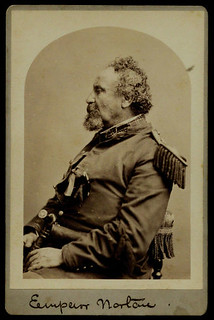 On the morning of 17 September 1859, Joshua Norton walked into the office of George Fitch, the editor of the San Francisco Evening
Bulletin newspaper, and handed Fitch a proclamation in which he, Norton, declared himself "Emperor of these United States."
On the morning of 17 September 1859, Joshua Norton walked into the office of George Fitch, the editor of the San Francisco Evening
Bulletin newspaper, and handed Fitch a proclamation in which he, Norton, declared himself "Emperor of these United States."
Fitch printed the proclamation in that evening's edition.
The Evening Bulletin was in the Montgomery Block, the legendary building of offices, parlors and saloons which — in the Emperor's day — was home to numerous prominent financiers, politicians, judges, writers and journalists.
The building stood on Montgomery Street, between Merchant and Washington — on a portion of the site where the landmark Transamerica Pyramid now stands.
Today, nestled immediately to the east of the Pyramid, a grove of redwoods anchors the lovely urban oasis of Redwood Park.
Directly across the street from the park is the former site of Fitch's editorial office — where Norton actually delivered his Proclamation — at 517 Clay.
Please join The Emperor's Bridge Campaign as we celebrate the foundation of Norton's Empire on 17 September 1859 and the continuation of that Empire into the present and the future — a borderless Empire of the heart open to all who have eyes to see and ears to hear.
We're calling it Empire Day — and we hope that this will mark the beginning of a new tradition.
Thursday 17 September 2015 at 6 p.m. sharp
Redwood Park (adjacent to the Transamerica Pyramid)*
San Francisco
* Enter on the Clay Street or Washington Street sides of the Park.
Redwood Park, which normally closes at 5:30 p.m., will be open by special arrangement.
It may be far from a coincidence that Joshua Norton chose 17 September to declare himself and his Empire — as this also was the date, in 1787, when delegates to the Constitutional Convention in Philadelphia signed the U.S. Constitution.
Today, 17 September is an official U.S. holiday known as Citizenship Day.
So please join us and declare yourself a citizen of the Empire!
Following a brief ceremony, we will adjourn to Comstock Saloon for a toast under the sculpture of Emperor Norton that presides over the saloon's 1907 bar.
To read the complete article, see:
Join Us in a New Tradition: Empire Day
(www.emperorsbridge.org/blog/2015/8/19/join-us-in-a-new-tradition-empire-day)
STEVE WOZNIAK'S PERFORATED PADS OF $2 BILLS
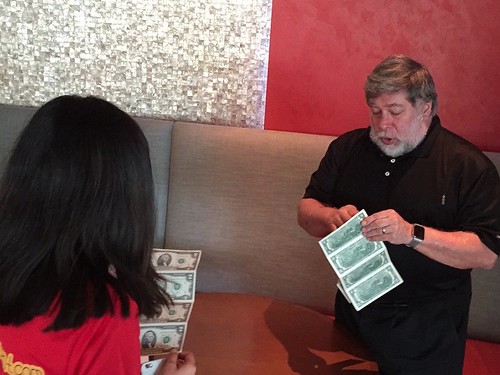
Steve Wozniak gives Sarina Khemchandani some of his self-printed $2 bills
About 3 years ago I took my daughter, Sara, to Las Vegas for a gymnastics regional that she was in. During the lengthy warmups my wife and I walked down to the Hard Rock Casino and played slot machines. While generously feeding these machines I tipped the waitress a couple of $2 bills. Waitresses in casinos and other places often exclaim at how much they like getting these and how their kids love them. I have tons of $2 bill stories that will make a whole chapter in my book someday. My $2 bills are real and legit but unusual.
These two $2 bills were attached to each other and perforated. You can purchase $1, $2, and now $5 bills from the Bureau of Printing and Engraving on sheets. The sheets come in sizes of 4, 16, and 32 bills each. I buy such sheets of $2 bills. I carry large sheets, folded in my pocket, and sometimes pull out scissors and cut a few off to pay for something in a store. It's just for comedy, as the $2 bills cost nearly $3 each when purchased on sheets. They cost even more at coin stores.
I take the sheets of 4 bills and have a printer, located through friends, gum them into pads, like stationery pads. The printer then perforates them between the bills, so that I can tear a bill or two away. The bills that I'd tipped the waitress came from such a pad.
We went into a room and the door was closed. This young Secret Service agent opened a chrome brief case on the table and pulled out a card. He said that he was going to read my my Miranda rights. Instantly I thought that I could just say "the bills are good and you know it and I'm leaving this bullshit" but then you always have the fear that they'll hold you for being uncooperative. It's hard to separate rights from reality. So I sat still and was read my Miranda rights. He pulled out forms and I thought that it was now going to take 20 minutes.
He asked my for some picture ID. I have some fake photo ID's that a friend made for me years before, when we could make realistic photo ID's from our computers. Almost nobody else could do this because printers weren't good enough. But I had an expensive early generation dye sublimation printer and made some fake ID's for fun. I had one favorite fake ID that I'd used for almost every airplane flight, domestic and international, that I'd taken for many years. It says "Laser Safety Officer" and has a photo of me with an eyepatch.
As I opened my wallet, I considered whether I should risk using this fake ID on the Secret Service. It probably amounted to a real crime. I had my driver's license as well. But you only live once and only a few of us even get a chance like this once in our lives. So I handed him the fake ID. He noted and returned it. The Secret Service took an ID that said "Laser Safety Officer" with a photo of myself wearing an eyepatch.
You can begin to see why many people don't believe this story when I tell it.
To read the complete article, see:
Letters-General Questions Answered
(http://archive.woz.org/letters/general/78.html)
To read the complete article, see:
9 amazing things we learned when a 14-year-old
interviewed Apple cofounder Steve Wozniak (www.businessinsider.com/how-a-14-year-old-scored-time-with-woz-2015-9)
